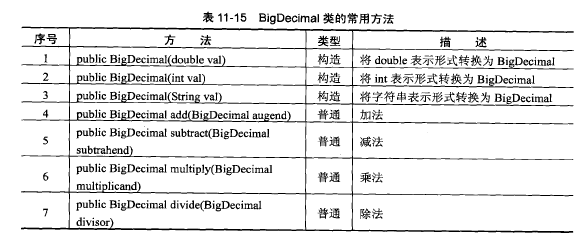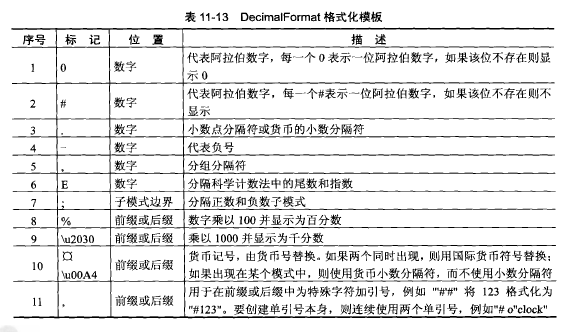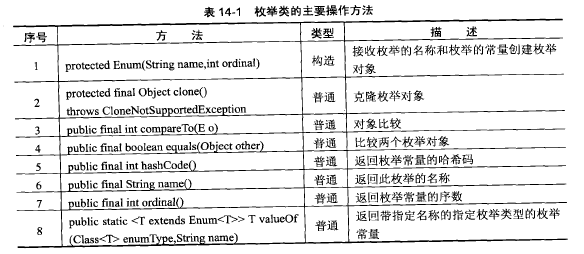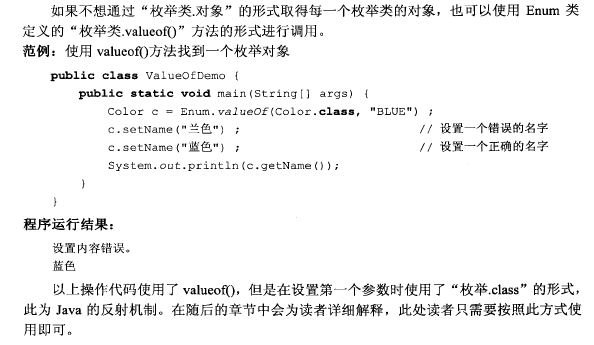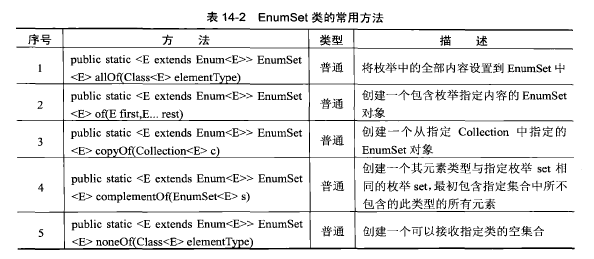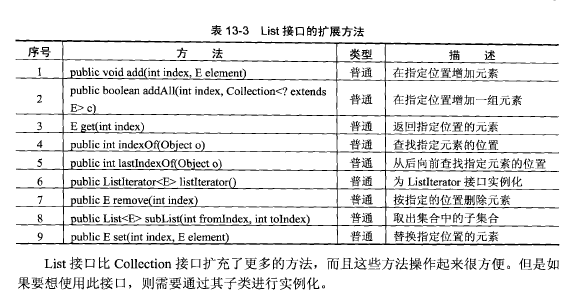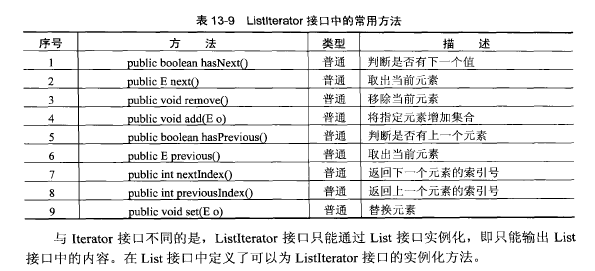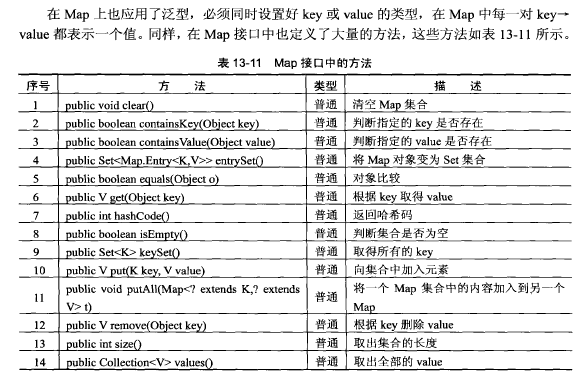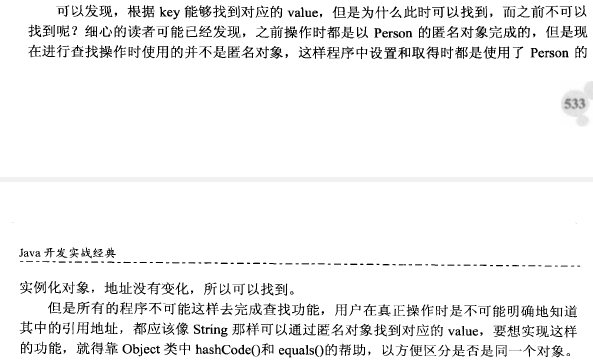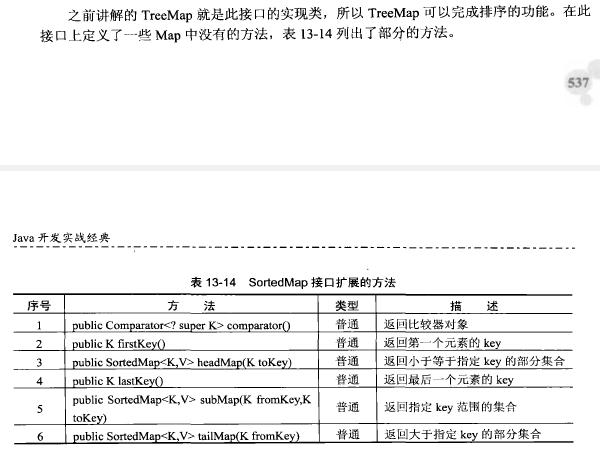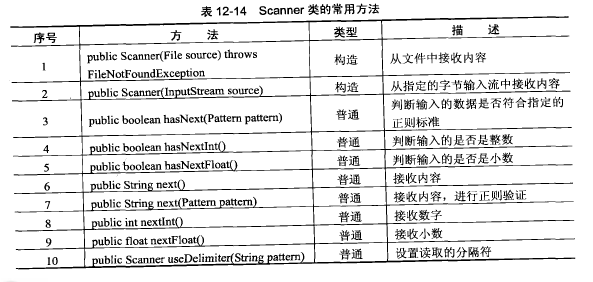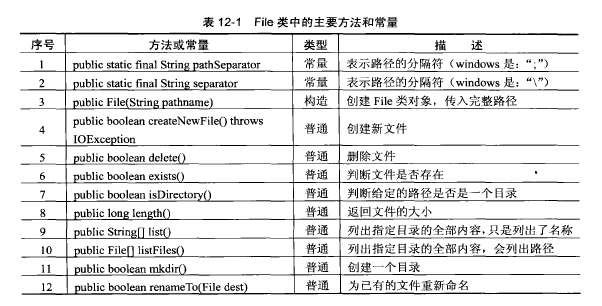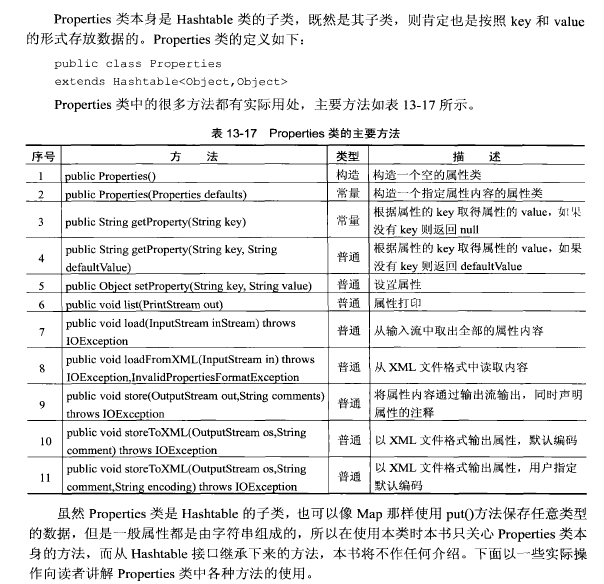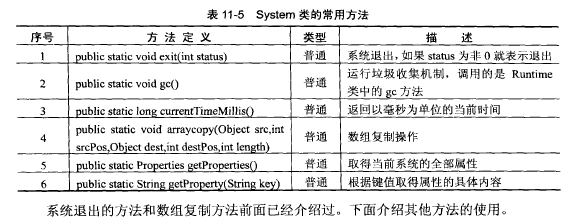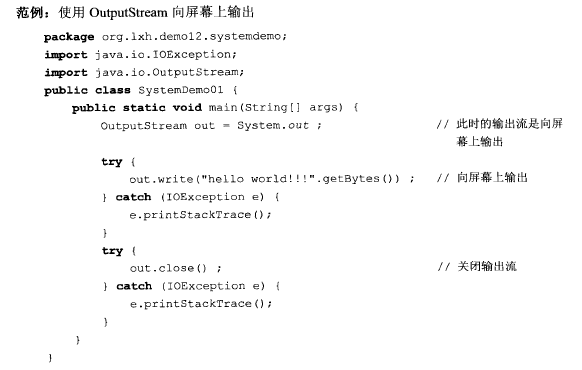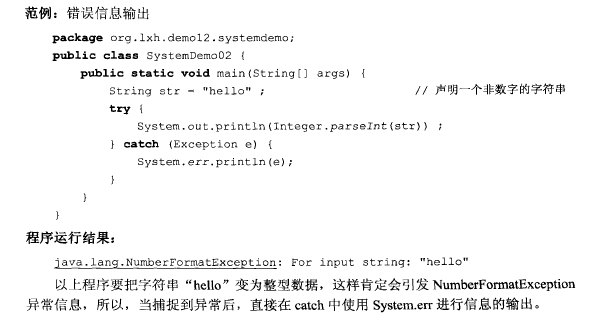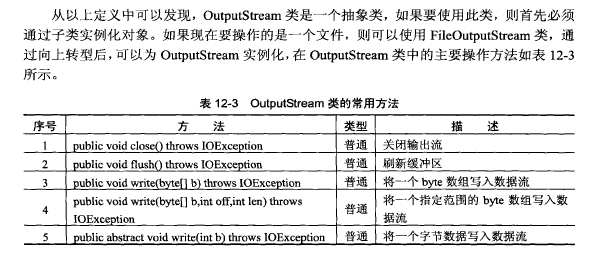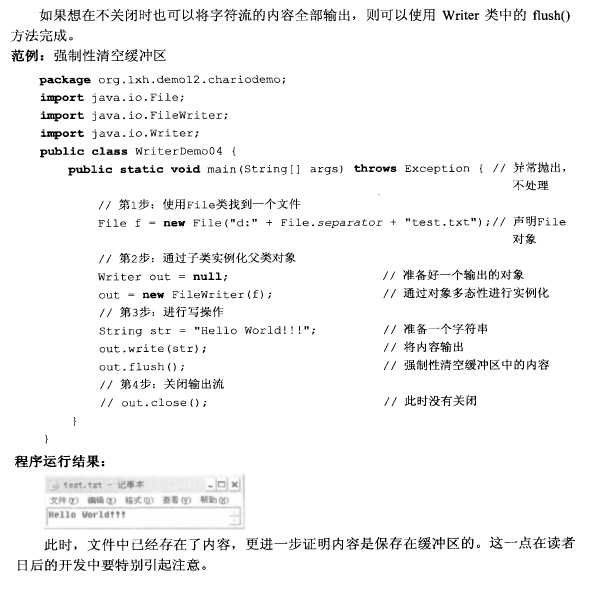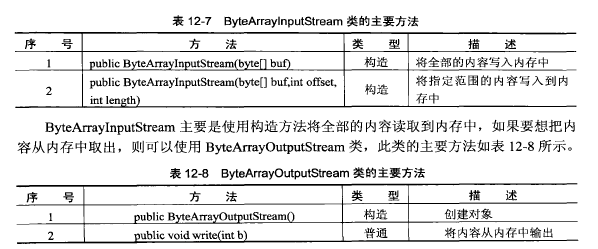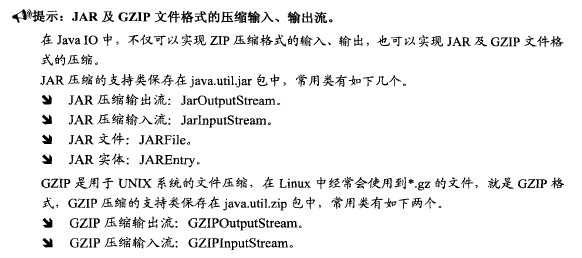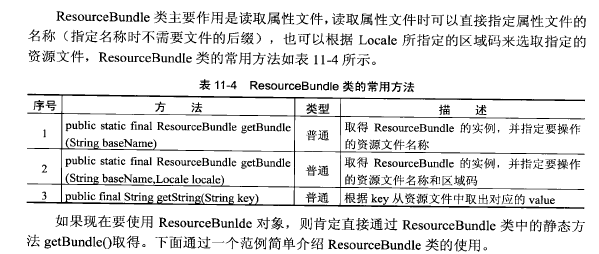1.基本格式 1 2 3 4 5 6 7 8 9 10 11 12 public class HelloWprdApp { public static void main(String[] args) { // TODO Auto-generated method stub int num = 10; num = 30; System.out.println("num="+num); System.out.println("num*num="+num*num); } }
String args[]:传统的写法,c、c++都用该种写法;
String[] args :Java的写法,但Java也能用上面的方法定义。
实际上String[] args 是定义一字符串数组变量。
在java中,String[] args和String args[] 都可以定义数组。二者没有什么区别。为规范编码,推荐使用String[] args。另外args可以随意改,和其它变量一样,它只不过是一变量名,只要符合变量名规则即可。
打印语句 :
1 2 3 System.Out.println(""); 带有换行 System.Out.print(""); 不带有换行
java申明一个类的方法有两种 :
public class 类名称要和文件的名称一样,否则不能编译
class 类名称可以和文件的名称不一样,编译时候生成的是 类名称.class
2.java基本数据类型
数据类型 大小/位 可表示的数据范围 默认值
long(长整数)
64
-2^63~2^63-1
0L
int(整数)
32
-2^31~2^31-1-0x800000000x7FFFFFFF-21474836482147483647
0
-0x800000000x7FFFFFFF127|0
当数值发生溢出 的时候,会形成循环,即最大值加上1后会变成最小值
强制转换类型的两种方法:
Integer.MAX_VALUE+2L 在加的数字后面加上L表示强制转换成长整形
((long)Integer.MAX_VALUE+2) 在加的数字前面加上long实现强制转换
如果需要精确的计算结果,则必须使用BigDecimal类 ,而且使用BigDecimal类也可以进行大数的操作。
1 2 3 4 5 6 7 8 9 10 11 12 13 14 15 16 17 18 19 20 21 22 23 24 25 26 27 28 29 30 31 32 33 34 35 36 37 38 39 40 41 42 43 44 45 46 import java.math.BigDecimal; class MyMath{ public static double add(double d1, double d2){ //进行加法运算 BigDecimal b1 = new BigDecimal(d1); BigDecimal b2 = new BigDecimal(d2); return b1.add(b2).doubleValue(); } public static double sub(double d1, double d2){ //进行减法运算 BigDecimal b1 = new BigDecimal(d1); BigDecimal b2 = new BigDecimal(d2); return b1.subtract(b2).doubleValue(); } public static double mul(double d1, double d2){ //进行乘法运算 BigDecimal b1 = new BigDecimal(d1); BigDecimal b2 = new BigDecimal(d2); return b1.multiply(b2).doubleValue(); } public static double div(double d1, double d2,int len){ //进行除法运算 BigDecimal b1 = new BigDecimal(d1); BigDecimal b2 = new BigDecimal(d2); return b1.divide(b2,len,BigDecimal.ROUND_HALF_UP).doubleValue(); //表示四舍五入 } public static double round(double d,int len){ //进行四舍五入 BigDecimal b1 = new BigDecimal(d); BigDecimal b2 = new BigDecimal(1); //任何一个数字除以1都是原数字 return b1.divide(b2,len,BigDecimal.ROUND_HALF_UP).doubleValue(); //表示四舍五入 } } public class BigDecimal_demo { public static void main(String[] args) { // TODO 自动生成的方法存根 System.out.println("加法运算:"+MyMath.round(MyMath.add(10.345, 3.333), 1)); System.out.println("加法运算:"+MyMath.round(MyMath.sub(10.345, 3.333), 1)); System.out.println("加法运算:"+MyMath.div(10.345, 3.333, 1)); System.out.println("加法运算:"+MyMath.round(MyMath.mul(10.345, 3.333), 1)); } }
3.常用的转义字符
转义字符 描述
\f 换页
*\*
反斜线
\b 倒退一格
' 单引号
\r 归位
" 双引号
\t 制表符tab
\n 换行
4.类型的转换 ** 当表示范围小的数值类型加上大的数值类型的时候,会自动转换成大的数值类型,比如short+int,会自动把结果转换成int型**
** 当数值类型加上字符串的时候,都转换成字符串类型**
5.数值格式化 1.NumberFormat表示数字的格式化类,即可以按照本地的风格习惯进行数字的显示。
NumberFormat是一个抽象类,和MessageFormat类一样,都是Format类的子类,本类在使用时可以直接使用NumberFormat类中提供的静态方法为其实例化。
1 2 3 4 5 6 7 8 9 10 11 12 13 14 import java.text.NumberFormat; public class NumberFormat_demo { public static void main(String[] args) { // TODO 自动生成的方法存根 NumberFormat nf = null; nf = NumberFormat.getInstance(); //返回当前默认语言环境的数字格式 System.out.println("格式化之后的数字:"+nf.format(1000000)); System.out.println("格式化之后的数字:"+nf.format(1000.345)); } }
2.DecimalFormat类也是Format的一个子类,主要作用是格式化数字。
在格式化数字的时候比直接使用NumberFormat更加方便,因为可以直接指定按用户自定义的方式进行格式化操作,与SimpleDateFormat类似,如果要进行自定义格式化操作,则必须指定格式化操作的模板。
1 2 3 4 5 6 7 8 9 10 11 12 13 14 15 16 17 18 19 20 21 22 23 24 25 26 import java.text.DecimalFormat; class FormatDemo{ public void format1(String pattern,double value){ DecimalFormat df = null; //声明一个DecimalFormat对象 df = new DecimalFormat(pattern); //实例化对象 String str = df.format(value); //格式化数字 System.out.println("使用"+pattern+"格式化数字"+value+":"+str); } } public class DecimalFormat_demo { public static void main(String[] args) { // TODO 自动生成的方法存根 FormatDemo demo = new FormatDemo(); demo.format1("###,###.###", 111222.34567); demo.format1("000,000.000", 11222.34567); demo.format1("###,###.###¥", 111222.34567); demo.format1("##.###%", 0.34567); //使用百分数形式 demo.format1("00.###%", 0.034567); //使用百分数形式 demo.format1("###.###\u2030", 0.34567); //使用千分数形式 } }
6.java枚举类型Enum 在JDK5中引入了一个新的关键字 ——enum ,可以直接定义枚举类型
在申明枚举类的时候,也可以申明属性、方法和构造函数,但枚举类的构造函数必须为私有的,不然就能new出枚举类
取出一个枚举内容
1 2 3 4 5 6 7 8 9 10 11 12 13 14 enum Color{ RED,GREEN,BLUE; } public class Enum_demo { public static void main(String[] args) { // TODO 自动生成的方法存根 Color c = Color.BLUE; System.out.println(c); } }
枚举类型的数据也可以使用“枚举.values()”的形式,将全部的枚举类型变为对喜爱数组的形式,之后再直接使用foreach进行输出
1 2 3 4 5 6 7 8 9 10 11 12 13 14 15 enum Color{ RED,GREEN,BLUE; } public class Enum_demo { public static void main(String[] args) { // TODO 自动生成的方法存根 for(Color c:Color.values()){ System.out.println(c); } } }
使用switch进行判断
1 2 3 4 5 6 7 8 9 10 11 12 13 14 15 16 17 18 19 20 21 22 23 24 25 26 27 28 29 30 31 32 33 34 35 36 enum Color{ RED,GREEN,BLUE; } public class Enum_demo { public static void main(String[] args) { // TODO 自动生成的方法存根 for(Color c:Color.values()){ print(c); } } public static void print(Color color){ switch(color){ case RED:{ System.out.println("红色"); break; } case GREEN:{ System.out.println("绿色"); break; } case BLUE:{ System.out.println("蓝色"); break; } default:{ System.out.println("其他颜色"); break; } } } }
使用name()和ordinal()方法取得名称和编号
1 2 3 4 5 6 7 8 9 10 11 12 13 14 15 enum Color{ RED,GREEN,BLUE; } public class Enum_demo { public static void main(String[] args) { // TODO 自动生成的方法存根 for(Color c:Color.values()){ System.out.println(c.ordinal()+"-->"+c.name()); } } }
** 通过构造方法为属性赋值**
通过把构造方法私有,使得不能new 一个新的Color对象,只能使用RED(“红色”),GREEN(“绿色”),BLUE(“蓝色”)三个类型
1 2 3 4 5 6 7 8 9 10 11 12 13 14 15 16 17 18 19 20 21 22 23 24 25 26 27 28 29 30 enum Color{ RED("红色"),GREEN("绿色"),BLUE("蓝色"); //定义枚举的3个类型,“红色”对应String name private Color(String name){ //定义私有构造方法 this.setName(name); } private String name; public String getName() { return name; } public void setName(String name) { this.name = name; } } public class Enum_demo { public static void main(String[] args) { // TODO 自动生成的方法存根 for(Color c:Color.values()){ System.out.println(c.ordinal()+"-->"+c.name()+c.getName()); } } }
通过setter()方法为属性赋值
枚举比较器
1 2 3 4 5 6 7 8 9 10 11 12 13 14 15 16 17 18 19 20 21 22 23 24 25 26 27 28 29 30 31 32 33 34 35 36 37 38 39 40 41 import java.util.Iterator; import java.util.Set; import java.util.TreeSet; enum Color{ RED("红色"),GREEN("绿色"),BLUE("蓝色"); //定义枚举的3个类型 private Color(String name){ //定义构造方法 this.setName(name); } private String name; public String getName() { return name; } public void setName(String name) { this.name = name; } } public class Enum_demo { public static void main(String[] args) { // TODO 自动生成的方法存根 Set<Color> t = new TreeSet<Color>(); t.add(Color.BLUE); t.add(Color.GREEN); t.add(Color.RED); Iterator<Color> iter = t.iterator(); while(iter.hasNext()){ System.out.println(iter.next()+"、"); } } }
EnumMap
EnumMap是Map接口的子类,所以本身还是以Map的形式进行操作,即Key–Value,
如果要使用EnumMap,则首先要创建EnumMap的对象,在创建对象的时候必须指定要操作的枚举类型
1 2 3 4 5 6 7 8 9 10 11 12 13 14 15 16 17 18 19 20 21 22 23 24 25 26 27 28 29 30 31 32 import java.util.EnumMap; import java.util.Map; enum color{ RED,GREEN,BLUE; //定义枚举的3个类型 } public class EnumMap_demo { public static void main(String[] args) { // TODO 自动生成的方法存根 Map<Color,String> desc = null; //定义一个Map对象 desc = new EnumMap<Color,String>(Color.class); //实例化EnumMap desc.put(Color.BLUE, "蓝色"); desc.put(Color.RED, "红色"); desc.put(Color.GREEN,"绿色"); for(Color c:Color.values()){ //取得全部的枚举 System.out.println(c.name()+"-->"+c.getName()); } for(Color c:desc.keySet()){ //取得全部的Key System.out.println(c.name()+"、"); } for(String c:desc.values()){ //取得全部的值 System.out.println(c+"、"); } } }
EnumSet
EnumSet是Set接口的子类,所以里面的内容是无法重复的。
使用EnumSet时不能直接使用关键字new为其进行实例化,所以在此类中提供了很多的静态方法
EnumSet—将全部的集合设置到EnumSet集合中
1 2 3 4 5 6 7 8 9 10 11 12 13 14 15 16 17 18 19 20 21 22 23 24 import java.util.EnumSet; enum color_{ RED,GREEN,BLUE; //定义枚举的3个类型 } public class EnumSet_demo { public static void main(String[] args) { // TODO 自动生成的方法存根 EnumSet<Color> es = null; //声明一个EnumSet对象 es = EnumSet.allOf(Color.class); //将枚举的全部类型设置到EnumSet对象中 print(es); } public static void print(EnumSet<Color> temp){ //专门的输出操作 for(Color c:temp){ //循环输出EnumSet中的内容 System.out.println(c+"、"); } } }
只设置一个枚举的类型到集合中
使用EnumSet提供的static方法of(),将一个枚举中的一个内容设置到EnumSet集合中
1 2 3 4 5 6 7 8 9 10 11 12 13 14 15 16 17 18 19 20 21 22 23 24 import java.util.EnumSet; enum color_{ RED,GREEN,BLUE; //定义枚举的3个类型 } public class EnumSet_demo { public static void main(String[] args) { // TODO 自动生成的方法存根 EnumSet<Color> es = null; //声明一个EnumSet对象 es = EnumSet.of(Color.BLUE); //设置一个枚举的内容 print(es); } public static void print(EnumSet<Color> temp){ //专门的输出操作 for(Color c:temp){ //循环输出EnumSet中的内容 System.out.println(c+"、"); } } }
创建只能放入指定枚举类型的集合
使用EnumSet提供的static方法noneOf(),将集合设置成只能增加Color类型的集合,但是并不设置任何的内容到集合中
1 2 3 4 5 6 7 8 9 10 11 12 13 14 15 16 17 18 19 20 21 22 23 24 25 26 27 import java.util.EnumSet; enum color_{ RED,GREEN,BLUE; //定义枚举的3个类型 } public class EnumSet_demo { public static void main(String[] args) { // TODO 自动生成的方法存根 EnumSet<Color> es = null; //声明一个EnumSet对象 es = EnumSet.noneOf(Color.class); //创建一个可以加入Color类型的对象 es.add(Color.BLUE); es.add(Color.RED); print(es); } public static void print(EnumSet<Color> temp){ //专门的输出操作 for(Color c:temp){ //循环输出EnumSet中的内容 System.out.println(c+"、"); } } }
创建不包含指定元素的集合
1 2 3 4 5 6 7 8 9 10 11 12 13 14 15 16 17 18 19 20 21 22 23 24 25 26 27 28 import java.util.EnumSet; enum color_{ RED,GREEN,BLUE; //定义枚举的3个类型 } public class EnumSet_demo { public static void main(String[] args) { // TODO 自动生成的方法存根 EnumSet<Color> esOld = null; //声明一个EnumSet对象 EnumSet<Color> esNew = null; //声明一个EnumSet对象 esOld = EnumSet.noneOf(Color.class); //创建一个可以加入Color类型的对象 esOld.add(Color.BLUE); esOld.add(Color.RED); esNew = EnumSet.complementOf(esOld); //创建一个不包含指定元素的集合 print(esNew); } public static void print(EnumSet<Color> temp){ //专门的输出操作 for(Color c:temp){ //循环输出EnumSet中的内容 System.out.println(c+"、"); } } }
复制已有的内容
1 2 3 4 5 6 7 8 9 10 11 12 13 14 15 16 17 18 19 20 21 22 23 24 25 26 27 28 29 import java.util.EnumSet; enum color_{ RED,GREEN,BLUE; //定义枚举的3个类型 } public class EnumSet_demo { public static void main(String[] args) { // TODO 自动生成的方法存根 EnumSet<Color> esOld = null; //声明一个EnumSet对象 EnumSet<Color> esNew = null; //声明一个EnumSet对象 esOld = EnumSet.noneOf(Color.class); //创建一个可以加入Color类型的对象 esOld.add(Color.BLUE); esOld.add(Color.RED); esNew = EnumSet.copyOf(esOld); //从已有的集合中复制出内容 print(esNew); } public static void print(EnumSet<Color> temp){ //专门的输出操作 for(Color c:temp){ //循环输出EnumSet中的内容 System.out.println(c+"、"); } } }
让枚举类实现一个接口
在接口中定义了一个getColor()方法,枚举类在实现此接口之后,就必须对枚举类中的每个对象分别实现接口中的getColor()方法
1 2 3 4 5 6 7 8 9 10 11 12 13 14 15 16 17 18 19 20 21 22 23 24 25 26 27 28 29 30 31 32 33 34 35 36 37 38 39 interface Print_{ //定义Print方法 public String getColor(); //定义抽象方法 } enum color_1 implements Print_{ //枚举类实现接口 RED{ //枚举对象实现抽象方法 @Override public String getColor() { // TODO 自动生成的方法存根 return "红色"; } }, BLUE{ @Override public String getColor() { // TODO 自动生成的方法存根 return "蓝色"; } }, GREEN{ @Override public String getColor() { // TODO 自动生成的方法存根 return "绿色"; } }; } public class InterfaceEnum_demo { public static void main(String[] args) { // TODO 自动生成的方法存根 for(color_1 c:color_1.values()){ //循环输出EnumSet中的内容 System.out.println(c.getColor()+"、"); } } }
在枚举类中定义抽象方法
1 2 3 4 5 6 7 8 9 10 11 12 13 14 15 16 17 18 19 20 21 22 23 24 25 26 27 28 29 30 31 32 33 34 35 36 37 38 39 40 41 42 43 44 45 46 47 48 49 50 51 52 53 54 55 56 57 58 59 60 61 62 63 64 65 66 67 interface Print_{ //定义Print方法 public String getColor(); //定义抽象方法 } //enum color_1 implements Print_{ //枚举类实现接口 // RED{ //枚举对象实现抽象方法 // @Override // public String getColor() { // // TODO 自动生成的方法存根 // return "红色"; // } // }, // BLUE{ // @Override // public String getColor() { // // TODO 自动生成的方法存根 // return "蓝色"; // } // }, // GREEN{ // @Override // public String getColor() { // // TODO 自动生成的方法存根 // return "绿色"; // } // }; //} enum color_1{ //枚举类实现接口 RED{ //枚举对象实现抽象方法 @Override public String getColor() { // TODO 自动生成的方法存根 return "红色"; } }, BLUE{ @Override public String getColor() { // TODO 自动生成的方法存根 return "蓝色"; } }, GREEN{ @Override public String getColor() { // TODO 自动生成的方法存根 return "绿色"; } }; public abstract String getColor(); //定义抽象方法 } //主类 //Function : InterfaceEnum_demo; public class InterfaceEnum_demo { public static void main(String[] args) { // TODO 自动生成的方法存根 for(color_1 c:color_1.values()){ //循环输出EnumSet中的内容 System.out.println(c.getColor()+"、"); } } }
7.位运算符 |位运算符 |描述 & |按位与 按位或 ^ |异或(相同为0,不同为1) ~ |取反 <<**|**左移位** |右移位 正数右移的时候左边补零,负数左边补一 >>> |无符号移位 正数负数右移的时候左边都补零
数组中,数组的名字,即地址存在栈内存中,地址指向的内容存在堆内存中,开辟新的堆内存必须要用关键字new,栈内存中存储的是堆内存的访问地址
当堆空间没有任何栈空间引用的时候,就成为了垃圾空间,等待这垃圾回收机制进行回收
数组的复制:System.arraycopy(i1,3,i2,1,3)源数组名称 源数组开始点 目标数组名称 目标数组开始点 复制长度
8.逻辑运算符优先级
9.方法的定义方式 1 2 3 4 public static void 方法名字(类型 参数,类型 参数。。。){ 程序语句 }
10.可变参数 1 2 3 4 5 6 7 8 9 fun(); fun(1); fun(1,2,3,4,5); public static void fun(int... arg){ for(int i=0;i<arg.lenght;i++){ system.out.print(arg[i]+"、"); }
11.类的定义 1 2 3 4 5 6 7 8 9 10 11 12 13 14 class Person{ private string name;//把属性封装,讲不能通过XX.name访问,必须通过setter和getter方法设置和取得 private int age;//private也可以用-表示 public Person(String name,int age){ //构造函数,和类名同名 this.setName(name); this.setAge(age); } public void tell(){ system.out.println(); } }
对象的创建和使用
** 类名 对象名称 = null;
** 对象名称 = new 类名();**
或者
** 类名 对象名称 = new 类名();
匿名对象
** new Person(“张三”,30).tell();//匿名对象,匿名对象一般是作为其他类实例化对象的参数传递,匿名对象是一个堆内存空间,没有栈空间
类设计分析
<1>根据要求写出类所包含的属性
<2>所有的属性都必须进行封装(private)
<3>封装之后的属性通过setter和getter设置和取得
<4>如果需要可以加入若干构造方法
<5>再根据其他要求添加相应的方法
<6>类中的所有方法都不要直接输出,而是交给被调用处输出
<7> 永远不要继承一个已经实现好的类,只能继承抽象类或者实现接口,因为一旦发生对象的向上转型关系后,所调用的方法一定是被子类所覆写的方法
12.Java内部类和包装类 在类Outer的内部再定义一个类Inner,此时类inner就称为内部类 ,而类outer则称为外部类。
内部类的唯一好处就是可以方便的访问外部类中的私有属性
1 2 3 4 5 6 7 8 9 10 11 12 13 14 15 16 17 18 19 20 21 22 class outer{ private String info = "Hello World!"; class inner{ public void print(){ System.out.println(info); } }; public void fun(){ new inner().print(); } }; public class inner_test { public static void main(String[] args) { // TODO 自动生成的方法存根 new outer().fun(); } }
使用static定义内部类
使用static声明的内部类变成了外部类,但是用static声明的内部类不能方位非static申明的外部类属性。
其中inner()要有static
1 2 3 4 5 6 7 8 9 10 11 12 13 14 15 16 17 class outer{ private static String info = "Hello World!"; static class inner{ public void print(){ System.out.println(info); } }; public class inner_test { public static void main(String[] args) { // TODO 自动生成的方法存根 new outer.inner().print(); } }
在外部访问内部类
一个内部类除了可以通过外部类访问,也可以直接在其他类中进行调用,调用的基本格式:
外部类.内部类 内部类对象 = 外部类实例.new 内部类();
1 2 3 4 5 6 7 8 9 10 11 12 13 14 15 16 17 18 19 20 21 22 23 24 25 26 27 28 29 30 31 32 33 34 35 36 37 38 39 40 41 42 43 44 45 46 47 public class Outer{ private static int i = 1; private int j=10; private int k=20; public static void outer_f1(){ //do more something } public void out_f2(){ //do more something } //成员内部类 class Inner{ //static int inner_i =100; //内部类中不允许定义静态变量 int j=100;//内部类中外部类的实例变量可以共存 int inner_i=1; void inner_f1(){ System.out.println(i);//外部类的变量如果和内部类的变量没有同名的,则可以直接用变量名访问外部类的变量 System.out.println(j);//在内部类中访问内部类自己的变量直接用变量名 System.out.println(this.j);//也可以在内部类中用"this.变量名"来访问内部类变量 //访问外部类中与内部类同名的实例变量可用"外部类名.this.变量名"。 System.out.println(k);//外部类的变量如果和内部类的变量没有同名的,则可以直接用变量名访问外部类的变量 outer_f1(); outer_f2(); } } //外部类的非静态方法访问成员内部类 public void outer_f3(){ Inner inner = new Inner(); inner.inner_f1(); } //外部类的静态方法访问成员内部类,与在外部类外部访问成员内部类一样 public static void outer_f4(){ //step1 建立外部类对象 Outer out = new Outer(); //***step2 根据外部类对象建立内部类对象*** Inner inner=out.new Inner(); //step3 访问内部类的方法 inner.inner_f1(); } public static void main(String[] args){ outer_f4(); } }
1 2 3 4 5 6 7 8 9 10 11 12 13 14 15 16 17 18 19 20 21 22 23 24 25 26 27 28 29 30 31 32 33 34 public class Outer { private int s = 100; private int out_i = 1; public void f(final int k){ final int s = 200; int i = 1; final int j = 10; class Inner{ //定义在方法内部 int s = 300;//可以定义与外部类同名的变量 //static int m = 20;//不可以定义静态变量 Inner(int k){ inner_f(k); } int inner_i = 100; void inner_f(int k){ System.out.println(out_i);//如果内部类没有与外部类同名的变量,在内部类中可以直接访问外部类的实例变量 System.out.println(k);//*****可以访问外部类的局部变量(即方法内的变量),但是变量必须是final的***** // System.out.println(i); System.out.println(s);//如果内部类中有与外部类同名的变量,直接用变量名访问的是内部类的变量 System.out.println(this.s);//用"this.变量名" 访问的也是内部类变量 System.out.println(Outer.this.s);//用外部"外部类类名.this.变量名" 访问的是外部类变量 } } new Inner(k); } public static void main(String[] args) { //访问局部内部类必须先有外部类对象 Outer out = new Outer(); out.f(3); } }
1 2 3 4 5 6 7 8 9 10 11 12 13 14 15 16 17 18 19 20 21 22 23 24 25 26 27 28 29 30 31 32 33 34 35 36 37 38 39 40 public class Outer { private static int i = 1; private int j = 10; public static void outer_f1(){ } public void outer_f2(){ } // 静态内部类可以用public,protected,private修饰 // 静态内部类中可以定义静态或者非静态的成员 static class Inner{ static int inner_i = 100; int inner_j = 200; static void inner_f1(){ System.out.println("Outer.i"+i);//静态内部类只能访问外部类的静态成员 outer_f1();//包括静态变量和静态方法 } void inner_f2(){ // System.out.println("Outer.i"+j);//静态内部类不能访问外部类的非静态成员 // outer_f2();//包括非静态变量和非静态方法 } } public void outer_f3(){ // 外部类访问内部类的静态成员:内部类.静态成员 System.out.println(Inner.inner_i); Inner.inner_f1(); // 外部类访问内部类的非静态成员:实例化内部类即可 Inner inner = new Inner(); inner.inner_f2(); } public static void main(String[] args) { new Outer().outer_f3(); } }
1 2 3 4 5 6 7 8 class People { run(); } class Machine{ run(); }
1 2 3 4 5 6 7 8 9 10 11 12 13 14 15 16 17 18 19 20 21 22 23 24 25 26 27 28 29 30 31 32 33 34 35 36 37 38 39 public class Outer { private static int i = 1; private int j = 10; public static void outer_f1(){ } public void outer_f2(){ } // 静态内部类可以用public,protected,private修饰 // 静态内部类中可以定义静态或者非静态的成员 static class Inner{ static int inner_i = 100; int inner_j = 200; static void inner_f1(){ System.out.println("Outer.i"+i);//静态内部类只能访问外部类的静态成员 outer_f1();//包括静态变量和静态方法 } void inner_f2(){ // System.out.println("Outer.i"+j);//静态内部类不能访问外部类的非静态成员 // outer_f2();//包括非静态变量和非静态方法 } } public void outer_f3(){ // 外部类访问内部类的静态成员:内部类.静态成员 System.out.println(Inner.inner_i); Inner.inner_f1(); // 外部类访问内部类的非静态成员:实例化内部类即可 Inner inner = new Inner(); inner.inner_f2(); } public static void main(String[] args) { new Outer().outer_f3(); } }
注:一个匿名内部类一定是在new的后面,用其隐含实现一个接口或实现一个类,没有类名,根据多态,我们使用其父类名。因他是局部内部类,那么局部内部类的所有限制都对其生效。匿名内部类是唯一一种无构造方法类。大部分匿名内部类是用于接口回调用的。匿名内部类在编译的时候由系统自动起名Out$1.class。如果一个对象编译时的类型是接口,那么其运行的类型为实现这个接口的类。因匿名内部类无构造方法,所以其使用范围非常的有限。当需要多个对象时使用局部内部类,因此局部内部类的应用相对比较多。匿名内部类中不能定义构造方法。如果一个对象编译时的类型是接口,那么其运行的类型为实现这个接口的类。
内部类总结:
1.首先,把内部类作为外部类的一个特殊的成员来看待,因此它有类成员的封闭等级:private ,protected,默认(friendly),public;
它有类成员的修饰符: static,final,abstract
2.非静态内部类nested inner class,内部类隐含有一个外部类的指针this,因此,它可以访问外部类的一切资源(当然包括private)
外部类访问内部类的成员,先要取得内部类的对象,并且取决于内部类成员的封装等级。
非静态内部类不能包含任何static成员
3.静态内部类:static inner class,不再包含外部类的this指针,并且在外部类装载时初始化.
静态内部类能包含static或非static成员.
静态内部类只能访问外部类static成员.
外部类访问静态内部类的成员,循一般类法规。对于static成员,用类名.成员即可访问,对于非static成员,只能用对象.成员进行访问
4.对于方法中的内部类或块中内部类只能访问块中或方法中的final变量。
类成员有两种static , non-static,同样内部类也有这两种
non-static 内部类的实例,必须在外部类的方法中创建或通过外部类的实例来创建(OuterClassInstanceName.new innerClassName(ConstructorParameter)),并且可直接访问外部类的信息,外部类对象可通过OuterClassName.this来引用
static 内部类的实例, 直接创建即可,没有对外部类实例的引用。
内部类不管static还是non-static都有对外部类的引用
non-static 内部类不允许有static成员
方法中的内部类只允许访问方法中的final局部变量和方法的final参数列表,所以说方法中的内部类和内部类没什麽区别。但方法中的内部类不能在方法以外访问,方法中不可以有static内部类
匿名内部类如果继承自接口,必须实现指定接口的方法,且无参数
匿名内部类如果继承自类,参数必须按父类的构造函数的参数传递
自动装箱 :指开发人员可以把一个基本数据类型 直接赋给对应的包装类
自动拆箱 :指开发人员可以把一个包装类对象 直接赋给对应的基本数据类型
要把基本数据类型 称为对象 的时候,需要把基本数据类型进行包装,
运用:把一个对象赋值给一个基本数据类型(一个由数字组成的字符串赋值给一个int或者float类型的基本数据类型)
比如:
1 2 3 4 5 6 7 8 List list = new ArrayList(); //集合List只能添加对象 list.add(1); //1是基本数据类型,自动装箱之后才能添加到集合中 Iterator i = list.iterator(); while(i.hasNext()){ int m = (Integer)i.next(); //next()方法返回的是Object,需要强转Integer之后,自动拆箱 }
包装类的应用 ,将一个全由数字组成的字符串 变成一个int或者float类型的基本数据
1 2 3 4 5 6 7 8 9 10 11 12 13 14 public class Wrapper_demo { public static void main(String[] args) { // TODO 自动生成的方法存根 String str1 = "30"; String str2 = "30.3"; int x = Integer.parseInt(str1); float f = Float.parseFloat(str2); System.out.println(x); System.out.println(f); } }
13.string对象 使用==比较string对象的时候比较的是string的地址
使用.equals方法比较的是string对象的内容
<1>使用string str = new string(“hello”);创建一个新的string对象,”hello”创建一个对象,new关键字又创建一个对象,所以建议使用第二种方法创建对象
<2>string str = “hello”;
注意:字符串的内容不可以修改,所以要避免对字符串的内容进行连续的修改,因为修改一次就要开辟两个新的内存空间,通过断开和连接进行字符串的修改。
要通过StringBuffer类进行修改。
14.引用 所谓引用传递 就是指将堆内存空间 的使用权交给多个栈内存空间 。
例子<1>
1 2 3 4 5 6 7 8 9 10 11 12 13 14 15 16 public class Aliasing { int temp = 30; public static void main(String[] args) { // TODO 自动生成的方法存根 Aliasing d1 = new Aliasing(); d1.temp = 50; System.out.println(d1.temp); fun(d1); System.out.println(d1.temp); } public static void fun (Aliasing d2){ d2.temp = 1000; } }
例子<2> 其中传递的是string对象,由于string的内容是不可以修改,所以str1的值还是hello,如果传递的是对象的string属性,那是可以修改的
1 2 3 4 5 6 7 8 9 10 11 12 13 14 15 public class Aliasing { int temp = 30; public static void main(String[] args) { // TODO 自动生成的方法存根 String str1 = "hello"; System.out.println(str1); fun(str1); System.out.println(str1); } public static void fun (String str2){ str2 = "hello2"; } }
例子<3>传递的是对象的string属性
1 2 3 4 5 6 7 8 9 10 11 12 13 14 15 16 public class Aliasing { String temp = "hello"; public static void main(String[] args) { // TODO 自动生成的方法存根 Aliasing d1 = new Aliasing(); d1.temp = "world"; System.out.println(d1.temp); fun(d1); System.out.println(d1.temp); } public static void fun (Aliasing d2){ d2.temp="HELLO"; } }
一对一关系 例子
一个人对应一本书,一本书对应一个人
1 2 3 4 5 6 7 8 9 10 11 12 13 14 15 16 17 18 19 20 21 22 23 24 25 26 27 28 29 30 31 32 33 34 35 36 37 38 39 40 41 42 43 44 45 46 47 48 49 50 51 52 53 54 55 56 57 58 59 60 61 62 63 64 65 66 67 68 69 70 71 72 73 74 75 76 77 78 79 80 81 82 83 84 85 86 class Person{ private String name; private int age; private Book book; public Person(String name,int age){ this.setName(name); this.setAge(age); } public String getName(){ return name; } public void setName(String n){ name = n; } public int getAge(){ return age; } public void setAge(int a){ age = a; } public Book getBook(){ return book; } public void setBook(Book b){ book = b; } } class Book{ private String title; private float price; private Person person; public Book(String title,float price){ this.setTitle(title); this.setPrice(price); } public String getTitle(){ return title; } public void setTitle(String t){ title = t; } public float getPrice(){ return price; } public void setPrice(float p){ price = p; } public Person getPerson(){ return person; } public void setPerson(Person person){ this.person = person; } } public class reference { public static void main(String[] args) { // TODO 自动生成的方法存根 Person per = new Person("zhangsan",30); Book bk = new Book("JAVA SE kaifa",90.0f); per.setBook(bk); bk.setPerson(per); System.out.println(" name "+per.getName()+" age "+per.getAge()+" book "+per.getBook().getTitle()+" price "+per.getBook().getPrice()); System.out.println(" title "+bk.getTitle()+" price "+bk.getPrice()+" person "+bk.getPerson().getName()+" age "+bk.getPerson().getAge()); } }
一个人对应一本书,一本书对应一个人,一个孩子对应一本书,一本书对应一个孩子,一个人对应一个孩子
1 2 3 4 5 6 7 8 9 10 11 12 13 14 15 16 17 18 19 20 21 22 23 24 25 26 27 28 29 30 31 32 33 34 35 36 37 38 39 40 41 42 43 44 45 46 47 48 49 50 51 52 53 54 55 56 57 58 59 60 61 62 63 64 65 66 67 68 69 70 71 72 73 74 75 76 77 78 79 80 81 82 83 84 85 86 87 88 89 90 91 92 93 94 95 96 97 98 99 100 class Person{ private String name; private int age; private Book book; private Person child; public Person(String name,int age){ this.setName(name); this.setAge(age); } public String getName(){ return name; } public void setName(String n){ name = n; } public int getAge(){ return age; } public void setAge(int a){ age = a; } public Book getBook(){ return book; } public void setBook(Book b){ book = b; } public Person getChild(){ return child; } public void setChild(Person child){ this.child = child; } } class Book{ private String title; private float price; private Person person; public Book(String title,float price){ this.setTitle(title); this.setPrice(price); } public String getTitle(){ return title; } public void setTitle(String t){ title = t; } public float getPrice(){ return price; } public void setPrice(float p){ price = p; } public Person getPerson(){ return person; } public void setPerson(Person person){ this.person = person; } } public class reference { public static void main(String[] args) { // TODO 自动生成的方法存根 Person per = new Person("zhangsan",30); Person cld = new Person("zhangcao",10); Book bk = new Book("JAVA SE kaifa",90.0f); Book b = new Book("11111",30.0f); per.setBook(bk); bk.setPerson(per); cld.setBook(b); b.setPerson(cld); per.setChild(cld); System.out.println(" name "+per.getName()+" age "+per.getAge()+" book "+per.getBook().getTitle()+" price "+per.getBook().getPrice()); System.out.println(" title "+bk.getTitle()+" price "+bk.getPrice()+" person "+bk.getPerson().getName()+" age "+bk.getPerson().getAge()); System.out.println(" cldname "+per.getChild().getName()+" age "+per.getChild().getAge()+" book "+per.getChild().getBook().getTitle()+" price "+per.getChild().getBook().getPrice()); } }
15.构造方法 识别合法的构造方法:
构造方法可以被重载,一个构造方法可以通过this关键字调用另一个构造方法,this语句必须位于构造方法的第一行;
重载:方法的重载(overload);重载构成的条件:方法的名称相同,但参数类型或参数个数不同,才能构成方法的重载.
当一个类中没有定义任何构造方法,Java将自动提供一个缺省的构造方法
子类通过super关键字调用父类的一个构造方法
当子类的某个构造方法没有通过super关键字调用父类的构造方法,通过这个构造方法创建子类对象时,会自动先调用父类的缺省构造方法
构造方法不能被static、final、synchronized、abstract、native修饰,但可以被public、private、protected修饰;
构造方法不是类的成员方法
构造方法不能被继承
16.Collections接口 <1>实例操作一:返回不可变的集合
Collections类中可以返回空的List、Set、Map集合,但是通过这种方式返回的对象是无法进行增加数据的,因为在这些操作中并没有实现add()方法
1 2 3 4 5 6 7 8 9 10 11 12 13 14 import java.util.Collections; import java.util.List; import java.util.Set; public class Collection_demo { public static void main(String[] args) { // TODO 自动生成的方法存根 List<String> allList = Collections.emptyList(); //返回不可变的空List集合 Set<String> allSet = Collections.emptySet(); //返回不可变的空List集合 } }
<2>实例操作二:为集合增加内容
1 2 3 4 5 6 7 8 9 10 11 12 13 14 15 16 17 18 19 20 21 22 import java.util.ArrayList; import java.util.Collections; import java.util.Iterator; import java.util.List; import java.util.Map; import java.util.Set; public class Collection_demo { public static void main(String[] args) { // TODO 自动生成的方法存根 List<String> all = new ArrayList<String>(); //实例化List Collections.addAll(all, "zhangsan","lisi","wangwu"); //增加内容 Iterator<String> iter = all.iterator(); //实例化iterator对象 while(iter.hasNext()){ System.out.println(iter.next()+"、"); } } }
<3>实例操作三:反转集合中的内容
1 2 3 4 5 6 7 8 9 10 11 12 13 14 15 16 17 18 19 20 21 22 23 import java.util.ArrayList; import java.util.Collections; import java.util.Iterator; import java.util.List; import java.util.Map; import java.util.Set; public class Collection_demo { public static void main(String[] args) { // TODO 自动生成的方法存根 List<String> all = new ArrayList<String>(); //实例化List Collections.addAll(all, "zhangsan","lisi","wangwu"); //增加内容 Collections.reverse(all); //内容反转保存 Iterator<String> iter = all.iterator(); //实例化iterator对象 while(iter.hasNext()){ System.out.println(iter.next()+"、"); } } }
<4>实例操作四:检索内容
1 2 3 4 5 6 7 8 9 10 11 12 13 14 15 16 17 18 19 20 21 22 23 24 25 26 27 import java.util.ArrayList; import java.util.Collections; import java.util.Iterator; import java.util.List; import java.util.Map; import java.util.Set; public class Collection_demo { public static void main(String[] args) { // TODO 自动生成的方法存根 List<String> all = new ArrayList<String>(); //实例化List Collections.addAll(all, "zhangsan","lisi","wangwu"); //增加内容 Collections.reverse(all); //内容反转保存 Iterator<String> iter = all.iterator(); //实例化iterator对象 while(iter.hasNext()){ System.out.println(iter.next()+"、"); } int point = Collections.binarySearch(all,"zhangsan"); System.out.println("检索结果:"+point); //输出位置 } }
<5>实例操作五:替换集合中的内容
1 2 3 4 5 6 7 8 9 10 11 12 13 14 15 16 17 18 19 20 21 22 23 24 25 26 27 28 29 30 31 32 import java.util.ArrayList; import java.util.Collections; import java.util.Iterator; import java.util.List; import java.util.Map; import java.util.Set; public class Collection_demo { public static void main(String[] args) { // TODO 自动生成的方法存根 // List<String> allList = Collections.emptyList(); //返回不可变的空List集合 // Set<String> allSet = Collections.emptySet(); //返回不可变的空List集合 List<String> all = new ArrayList<String>(); //实例化List Collections.addAll(all, "zhangsan","lisi","wangwu"); //增加内容 Collections.replaceAll(all, "wangwu", "lisi"); //替换内容 Collections.reverse(all); //内容反转保存 Iterator<String> iter = all.iterator(); //实例化iterator对象 while(iter.hasNext()){ System.out.println(iter.next()+"、"); } int point = Collections.binarySearch(all,"zhangsan"); System.out.println("检索结果:"+point); //输出位置 } }
<6>实例操作六:集合排序
1 2 3 4 5 6 7 8 9 10 11 12 13 14 15 16 17 18 19 20 21 22 23 24 25 26 27 28 29 30 31 32 33 34 35 36 37 38 39 import java.util.ArrayList; import java.util.Collections; import java.util.Iterator; import java.util.List; import java.util.Map; import java.util.Set; public class Collection_demo { public static void main(String[] args) { // TODO 自动生成的方法存根 // List<String> allList = Collections.emptyList(); //返回不可变的空List集合 // Set<String> allSet = Collections.emptySet(); //返回不可变的空List集合 List<String> all = new ArrayList<String>(); //实例化List Collections.addAll(all, "zhangsan","lisi","wangwu"); //增加内容 // Collections.replaceAll(all, "wangwu", "lisi"); //替换内容 // Collections.reverse(all); //内容反转保存 Iterator<String> iter = all.iterator(); //实例化iterator对象 while(iter.hasNext()){ System.out.println(iter.next()+"、"); } Collections.sort(all); System.out.println("排序之后的集合"); iter = all.iterator(); while(iter.hasNext()){ System.out.println(iter.next()+"、"); } int point = Collections.binarySearch(all,"zhangsan"); System.out.println("检索结果:"+point); //输出位置 } }
<7>实例操作七:交换指定位置的内容
直接使用swap()方法可以把集合中两个位置的内容进行交换
1 2 3 4 5 6 7 8 9 10 11 12 13 14 15 16 17 18 19 20 21 22 23 24 25 26 27 28 29 30 31 32 33 34 35 36 37 38 39 import java.util.ArrayList; import java.util.Collections; import java.util.Iterator; import java.util.List; import java.util.Map; import java.util.Set; public class Collection_demo { public static void main(String[] args) { // TODO 自动生成的方法存根 // List<String> allList = Collections.emptyList(); //返回不可变的空List集合 // Set<String> allSet = Collections.emptySet(); //返回不可变的空List集合 List<String> all = new ArrayList<String>(); //实例化List Collections.addAll(all, "zhangsan","lisi","wangwu"); //增加内容 // Collections.replaceAll(all, "wangwu", "lisi"); //替换内容 // Collections.reverse(all); //内容反转保存 Iterator<String> iter = all.iterator(); //实例化iterator对象 while(iter.hasNext()){ System.out.println(iter.next()+"、"); } // Collections.sort(all); Collections.swap(all,0,2); //交换指定位置的内容 System.out.println("排序之后的集合"); iter = all.iterator(); while(iter.hasNext()){ System.out.println(iter.next()+"、"); } int point = Collections.binarySearch(all,"zhangsan"); System.out.println("检索结果:"+point); //输出位置 } }
17.List接口 List是Collection的子接口 ,其中可以保存各个重复的内容 。
List接口的常用子类
1.ArrayList
<1>实例操作一:向集合中增加元素
<2>实例操作二:删除元素
<3>实例操作三:输出List中的内容
<4>实例操作四:将集合变为对象数组
1 2 3 4 5 6 7 8 9 10 11 12 13 14 15 16 17 18 19 20 21 22 23 24 25 26 27 28 29 30 31 32 33 34 35 36 37 38 39 40 41 42 43 44 45 46 47 48 49 50 51 52 53 54 55 56 57 58 59 60 61 import java.util.ArrayList; import java.util.Collection; import java.util.List; public class List_demo { public static void main(String[] args) { // TODO 自动生成的方法存根 List<String> allList = null; //定义List对象 Collection<String> allCollection = null; //定义Collection对象 allList = new ArrayList<String>(); //实例化List对象,只能是String类型 allCollection = new ArrayList<String>(); //实例化Collection,只能是String类型 allList.add("Hello"); //是从Collection继承的方法 allList.add(0,"Word"); //此方法为List扩充的方法 System.out.println(allList); //输出集合中的内容 allCollection.add("zhangsan"); //增加数据 allCollection.add("www.baidu.com"); //增加数据 allList.addAll(allCollection); //是从Collection继承的方法,增加一组对象 allList.addAll(0,allCollection); //是从Collection继承的方法,增加一组对象 System.out.println(allList); //输出集合中的内容 allList.remove(0); //删除指定位置的元素 allList.remove("Hello"); //删除指定内容的元素 System.out.println(allList); //输出集合中的内容 System.out.println("从前向后输出:"); for(int i=0;i<allList.size();i++){ System.out.println(allList.get(i)+"、"); } System.out.println("从后向前输出:"); for(int i=allList.size()-1;i>=0;i--){ System.out.println(allList.get(i)+"、"); } String str[] =allList.toArray(new String[] {}); //指定的泛型类型 System.out.println("转换为数组类型"); for(int i =0;i<str.length;i++){ System.out.println(str[i]+"、"); } System.out.println("返回对象数组"); Object obj[] = allList.toArray(); for(int i =0;i<obj.length;i++){ String temp = (String) obj[i]; System.out.println(temp+"、"); } System.out.println(allList.contains("zhangsan")?"字符串存在":"字符串不存在"); List<String> allSub = allList.subList(0, 2); //取出里面的部分集合,前两个 System.out.println(allSub); //输出集合中的内容 System.out.println("字符串的位置"+allList.indexOf("zhangsan")); //查询字符串的位置 System.out.println("集合操作后是否为空?"+allList.isEmpty()); } }
2.LinkedList子类与Queue接口
LinkedList 表示的是一个链表的操作类,即Java中已经为开发者提供好了一个链表程序,开发者直接使用即可,无需再重新开发。
<1>实例操作一:在链表的开头和结尾增加数据
<2>实例操作二:找到链表头
<3>实例操作三:以先进先出的方式取出全部的数据
1 2 3 4 5 6 7 8 9 10 11 12 13 14 15 16 17 18 19 20 21 22 23 24 25 26 27 28 29 30 31 32 33 34 import java.util.LinkedList; public class LinkedList_demo { public static void main(String[] args) { // TODO 自动生成的方法存根 LinkedList<String> link = new LinkedList<String>(); link.add("A"); link.add("B"); link.add("C"); System.out.println("初始化链表:"+link); //输出链表内容,调用toString link.addFirst("X"); link.addLast("Y"); System.out.println("添加头尾之后的链表:"+link); //输出链表内容,调用toString System.out.println("使用element()方法找到表头:"+link.element()); System.out.println("找到之后的link内容"+link); System.out.println("使用peek()方法找到表头:"+link.peek()); System.out.println("找到之后的link内容"+link); System.out.println("使用poll()方法找到表头:"+link.poll()); System.out.println("找到之后的link内容"+link); System.out.println("以先进先出的方式输出:"); for(int i=0;i<link.size()+1;i++){ System.out.println(link.poll()+"、"); } } }
在类集中提供了以下4种常见的输出方式。
**Iterator:**迭代输出,是使用最多的输出方式
**ListIterator:**是Iterator的子接口,专门用于输出List的内容
**Enumeration:**是一个旧的接口,功能与Iterator类似
**foreach:**JDK1.5之后提供的新功能,可以输出数组或者集合
Iterator:迭代输出
碰到集合输出的操作,就一定使用Iterator 接口
所谓的迭代输出接口就是将元素一个个进行判断,判断其是否有内容,如果有内容则把内容取出。
<1>实例操作一:输出Collection中的全部内容
1 2 3 4 5 6 7 8 9 10 11 12 13 14 15 16 17 18 19 20 21 22 23 24 import java.util.ArrayList; import java.util.Iterator; import java.util.List; import java.util.SortedSet; import java.util.TreeSet; public class Iterator_demo { public static void main(String[] args) { // TODO 自动生成的方法存根 List<String> all = new ArrayList<String>(); //实例化List接口 all.add("A"); all.add("C"); all.add("D"); all.add("E"); all.add("B"); Iterator<String> iter = all.iterator(); //直接实例化Iterator接口 while(iter.hasNext()){ //依次判断 System.out.println(iter.next()+"、"); //输出内容 } } }
<2>实例操作二:使用Iterator删除指定内容
1 2 3 4 5 6 7 8 9 10 11 12 13 14 15 16 17 18 19 20 21 22 23 24 25 26 27 28 29 import java.util.ArrayList; import java.util.Iterator; import java.util.List; import java.util.SortedSet; import java.util.TreeSet; public class Iterator_demo { public static void main(String[] args) { // TODO 自动生成的方法存根 List<String> all = new ArrayList<String>(); //实例化List接口 all.add("A"); all.add("C"); all.add("D"); all.add("E"); all.add("B"); Iterator<String> iter = all.iterator(); //直接实例化Iterator接口 while(iter.hasNext()){ //依次判断 String str = iter.next(); //取出内容 if("A".equals(str)){ iter.remove(); }else{ System.out.println(str+"、"); //输出内容 } } } }
ListIterator:双向迭代输出
ListIterator接口的主要功能是由前向后单向输出,而此时如果想实现有后向前或是由前向后的双向输出,则必须使用Iterator接口的子接口——ListIterator。
<1>进行双向迭代
<2>增加及代替元素
1 2 3 4 5 6 7 8 9 10 11 12 13 14 15 16 17 18 19 20 21 22 23 24 25 26 27 28 29 30 31 32 33 import java.util.ArrayList; import java.util.Iterator; import java.util.List; import java.util.ListIterator; public class ListIterator_demo { public static void main(String[] args) { // TODO 自动生成的方法存根 List<String> all = new ArrayList<String>(); //实例化List接口 all.add("C"); all.add("D"); all.add("E"); all.add("A"); all.add("B"); ListIterator<String> iter = all.listIterator(); //实例化ListIterator接口 System.out.println("由前向后输出:"); //信息输出 while(iter.hasNext()){ //依次判断 String str = iter.next(); //取出内容 System.out.println(str+"、"); //输出内容 iter.set("LIN-"+str); //替换元素 } System.out.println("由后向前输出:"); //信息输出 iter.add("TONY"); //增加元素 while(iter.hasPrevious()){ //依次判断 String str = iter.previous(); //取出内容 System.out.println(str+"、"); //输出内容 } } }
18.Set接口 Set接口也是Collection接口的子接口,Set接口中不能加入重复的元素
Set接口的常用子类
1、散列的存放:HashSet
HashSet是Set接口的一个子类,主要的特点是:里面不能存放重复的元素,而且采用散列的存储方式,所以没有顺序。
2、有序的存放:TreeSet
1 2 3 4 5 6 7 8 9 10 11 12 13 14 15 16 17 18 19 20 21 22 import java.util.HashSet; import java.util.LinkedList; import java.util.Set; import java.util.TreeSet; public class Set_demo { public static void main(String[] args) { // TODO 自动生成的方法存根 // Set<String> allSet = new HashSet<String>(); //无序 Set<String> allSet = new TreeSet<String>(); //有序 allSet.add("A"); allSet.add("C"); allSet.add("D"); allSet.add("E"); allSet.add("B"); System.out.println(allSet); //输出集合内容,调用toString } }
TreeSet中实现了SortedSet接口,此接口主要用于排序操作,即实现此接口的子类都属于排序的子类。
1 2 3 4 5 6 7 8 9 10 11 12 13 14 15 16 17 18 19 20 21 22 23 import java.util.Set; import java.util.SortedSet; import java.util.TreeSet; public class SortedSet_demo { public static void main(String[] args) { // TODO 自动生成的方法存根 SortedSet<String> allSet = new TreeSet<String>(); //有序 allSet.add("A"); allSet.add("C"); allSet.add("D"); allSet.add("E"); allSet.add("B"); System.out.println("第一个元素:"+allSet.first()); System.out.println("最后一个元素:"+allSet.last()); System.out.println("headSet元素:"+allSet.headSet("c")); System.out.println("tailSet元素:"+allSet.tailSet("C")); System.out.println("subSet元素:"+allSet.subSet("B","D")); } }
19.Map接口 Collection、Set、List接口 都属于单值的操作,即每次只能操作一个对象,
而Map 与他们不同的是,每次操作的是一对对象,即二元偶对象 ,Map中的每个元素都使用key->value 的形式存储在集合中。
<1>实例操作一:向集合中增加和取出内容
在Map接口中使用put(Object key,Object value)方法可以向集合中增加内容,之后通过get(E key)方法根据key找到其对应的value
1 2 3 4 5 6 7 8 9 10 11 12 13 14 15 16 17 18 19 import java.util.HashMap; import java.util.Map; public class Map_demo { public static void main(String[] args) { // TODO 自动生成的方法存根 Map<String,String> map = null; //声明Map对象 map = new HashMap<String,String>(); //key和value是String类 map.put("zhangsan", "www.baidu.com"); //增加内容 map.put("lisi", "www.alibaba.com"); //增加内容 map.put("wangwu", "www.google.com"); //增加内容 String val = map.get("zhangsan"); System.out.println("取出内容:"+val); } }
<2>实例操作二:判断指定的key或者value是否存在
1 2 3 4 5 6 7 8 9 10 11 12 13 14 15 16 17 18 19 20 21 22 23 24 25 26 27 28 29 30 import java.util.HashMap; import java.util.Map; public class Map_demo { public static void main(String[] args) { // TODO 自动生成的方法存根 Map<String,String> map = null; //声明Map对象 map = new HashMap<String,String>(); //key和value是String类 map.put("zhangsan", "www.baidu.com"); //增加内容 map.put("lisi", "www.alibaba.com"); //增加内容 map.put("wangwu", "www.google.com"); //增加内容 String val = map.get("zhangsan"); System.out.println("取出内容:"+val); if(map.containsKey("zhangsan")){ //查找指定的key System.out.println("搜索的key存在"); }else{ System.out.println("搜索的key不存在"); } if(map.containsValue("www.baidu.com")){ //查找指定的value System.out.println("搜索的value存在"); }else{ System.out.println("搜索的value不存在"); } } }
<3>实例操作三:输出全部的key
1 2 3 4 5 6 7 8 9 10 11 12 13 14 15 16 17 18 19 20 21 22 23 24 25 26 27 28 import java.util.HashMap; import java.util.Iterator; import java.util.Map; import java.util.Set; public class Map_demo { public static void main(String[] args) { // TODO 自动生成的方法存根 Map<String,String> map = null; //声明Map对象 map = new HashMap<String,String>(); //key和value是String类 map.put("zhangsan", "www.baidu.com"); //增加内容 map.put("lisi", "www.alibaba.com"); //增加内容 map.put("wangwu", "www.google.com"); //增加内容 Set<String> keys = map.keySet(); //取得所有的key Iterator<String> iter = keys.iterator(); //实例化Iterator System.out.println("全部的key:"); while(iter.hasNext()){ String str = iter.next(); //取出集合的key System.out.println(str+"、"); } } }
<4>实例操作三:输出全部的value
1 2 3 4 5 6 7 8 9 10 11 12 13 14 15 16 17 18 19 20 21 22 23 24 25 26 27 28 import java.util.Collection; import java.util.HashMap; import java.util.Iterator; import java.util.Map; import java.util.Set; public class Map_demo { public static void main(String[] args) { // TODO 自动生成的方法存根 Map<String,String> map = null; //声明Map对象 map = new HashMap<String,String>(); //key和value是String类 map.put("zhangsan", "www.baidu.com"); //增加内容 map.put("lisi", "www.alibaba.com"); //增加内容 map.put("wangwu", "www.google.com"); //增加内容 Collection<String> values = map.values(); //取得所有的value Iterator<String> iter = values.iterator(); //实例化Iterator System.out.println("全部的values:"); while(iter.hasNext()){ String str = iter.next(); //取出集合的key System.out.println(str+"、"); } } }
旧的子类:Hashtable
Hashtable也是Map中的一个子类,属于旧的操作类
1 2 3 4 5 6 7 8 9 10 11 12 13 14 15 16 17 18 19 20 21 22 23 24 25 26 27 28 29 30 31 32 33 34 35 36 import java.util.Collection; import java.util.HashMap; import java.util.Hashtable; import java.util.Iterator; import java.util.Map; import java.util.Set; public class Map_demo { public static void main(String[] args) { // TODO 自动生成的方法存根 Map<String,String> map = null; //声明Map对象 map = new Hashtable<String,String>(); //key和value是String类 map.put("zhangsan", "www.baidu.com"); //增加内容 map.put("lisi", "www.alibaba.com"); //增加内容 map.put("wangwu", "www.google.com"); //增加内容 Set<String> keys = map.keySet(); //取得所有的key Iterator<String> iter = keys.iterator(); //实例化Iterator System.out.println("全部的key:"); while(iter.hasNext()){ String str = iter.next(); //取出集合的key System.out.println(str+"、"); } Collection<String> values = map.values(); //取得所有的value Iterator<String> iter2 = values.iterator(); //实例化Iterator System.out.println("全部的values:"); while(iter2.hasNext()){ String str = iter2.next(); //取出集合的value System.out.println(str+"、"); } } }
排序的子类:TreeMap
排序后输出
1 2 3 4 5 6 7 8 9 10 11 12 13 14 15 16 17 18 19 20 21 22 23 24 25 26 27 28 29 import java.util.Collection; import java.util.HashMap; import java.util.Hashtable; import java.util.Iterator; import java.util.Map; import java.util.Set; import java.util.TreeMap; public class Map_demo { public static void main(String[] args) { // TODO 自动生成的方法存根 Map<String,String> map = null; //声明Map对象 map = new TreeMap<String,String>(); //实例化Map对象 map.put("B", "www.baidu.com"); //增加内容 map.put("A", "www.alibaba.com"); //增加内容 map.put("C", "www.google.com"); //增加内容 Set<String> keys = map.keySet(); //取得所有的key Iterator<String> iter = keys.iterator(); //实例化Iterator System.out.println("全部的key:"); while(iter.hasNext()){ String str = iter.next(); //取出集合的key,排序后输出 System.out.println(str+"、"); } } }
弱引用类:WeakHashMap
之前的Map子类中的数据都是使用强引用保存的,即里面的内容不管是否使用都始终在集合中保留,如果希望集合自动清理暂时不用的数据就使用WeakHashMap类。这样,当进行垃圾收集时会释放掉集合中的垃圾信息。
1 2 3 4 5 6 7 8 9 10 11 12 13 14 15 16 17 18 19 20 21 22 23 24 25 import java.util.Collection; import java.util.HashMap; import java.util.Hashtable; import java.util.Iterator; import java.util.Map; import java.util.Set; import java.util.TreeMap; import java.util.WeakHashMap; public class Map_demo { public static void main(String[] args) { // TODO 自动生成的方法存根 Map<String,String> map = null; //声明Map对象 map = new WeakHashMap<String,String>(); //实例化Map对象 map.put(new String("B"), new String("www.baidu.com")); //增加内容 map.put("A", "www.alibaba.com"); //增加内容 System.gc(); map.put("C", "www.google.com"); //增加内容 System.out.println("内容:"+map); } }
Map输出方式一:Iterator输出Map(使用 allSet = map.entrySet();,重要:开发中经常使用 )
1 2 3 4 5 6 7 8 9 10 11 12 13 14 15 16 17 18 19 20 21 22 23 24 25 26 27 28 29 30 31 import java.util.Collection; import java.util.HashMap; import java.util.Hashtable; import java.util.Iterator; import java.util.Map; import java.util.Set; import java.util.TreeMap; import java.util.WeakHashMap; public class Map_demo { public static void main(String[] args) { // TODO 自动生成的方法存根 Map<String,String> map = null; //声明Map对象 map = new WeakHashMap<String,String>(); //实例化Map对象 map.put("B", "www.baidu.com"); //增加内容 map.put("A", "www.alibaba.com"); //增加内容 map.put("C", "www.google.com"); //增加内容 Set<Map.Entry<String, String>> allSet = null; //声明一个Set集合,指定泛型 allSet = map.entrySet(); //将Map接口实例变为Set接口实例 Iterator<Map.Entry<String, String>> iter = null; //声明Iterator对象 iter = allSet.iterator(); //实例化Iterator对象 while(iter.hasNext()){ Map.Entry<String, String> me = iter.next(); //找到Map.Entry实例 System.out.println(me.getKey()+"-->"+me.getValue()); } } }
Map输出方式二:foreach输出Map
1 2 3 4 5 6 7 8 9 10 11 12 13 14 15 16 17 18 19 20 21 22 23 24 25 26 27 28 import java.util.Collection; import java.util.HashMap; import java.util.Hashtable; import java.util.Iterator; import java.util.Map; import java.util.Set; import java.util.TreeMap; import java.util.WeakHashMap; public class Map_demo { public static void main(String[] args) { // TODO 自动生成的方法存根 Map<String,String> map = null; //声明Map对象 map = new WeakHashMap<String,String>(); //实例化Map对象 map.put("B", "www.baidu.com"); //增加内容 map.put("A", "www.alibaba.com"); //增加内容 map.put("C", "www.google.com"); //增加内容 for(Map.Entry<String, String> me: map.entrySet()){ System.out.println(me.getKey()+"-->"+me.getValue()); } } }
直接使用非系统类作为Key
1 2 3 4 5 6 7 8 9 10 11 12 13 14 15 16 17 18 19 20 21 22 import java.util.Collection; import java.util.HashMap; import java.util.Hashtable; import java.util.Iterator; import java.util.Map; import java.util.Set; import java.util.TreeMap; import java.util.WeakHashMap; public class Map_demo { public static void main(String[] args) { // TODO 自动生成的方法存根 Map<String,person> map = null; //声明Map对象,指定泛型类型 map = new HashMap<String,person>(); //实例化Map对象 map.put("zhangsan", new person("张三",30)); System.out.println(map.get("zhangsan")); } }
key可以重复的Map集合:IdentityHashMap
1 2 3 4 5 6 7 8 9 10 11 12 13 14 15 16 17 18 19 20 21 22 23 24 25 26 27 28 29 30 31 32 import java.util.Collection; import java.util.HashMap; import java.util.Hashtable; import java.util.IdentityHashMap; import java.util.Iterator; import java.util.Map; import java.util.Set; import java.util.TreeMap; import java.util.WeakHashMap; public class Map_demo { public static void main(String[] args) { // TODO 自动生成的方法存根 Map<person,String> map = null; //声明Map对象,指定泛型类型 map = new IdentityHashMap<person,String>(); //实例化Map对象 map.put(new person("张三",30),"zhangsan_1"); map.put(new person("张三",30),"zhangsan_1"); Set<Map.Entry<person, String>> allSet = null; allSet = map.entrySet(); Iterator<Map.Entry<person, String>> iter = null; iter = allSet.iterator(); while(iter.hasNext()){ Map.Entry<person, String> me = iter.next(); //找到Map.Entry实例 System.out.println(me.getKey()+"-->"+me.getValue()); } } }
SortedMap接口是排序接口,只要是实现了此接口的子类,都属于排序的子类,TreeMap也是此接口的一个子类。
1 2 3 4 5 6 7 8 9 10 11 12 13 14 15 16 17 18 19 20 21 22 23 24 25 26 27 28 29 30 31 32 33 34 35 36 import java.util.Map; import java.util.SortedMap; import java.util.TreeMap; public class SortedMap_demo { public static void main(String[] args) { // TODO 自动生成的方法存根 SortedMap<String,String> map = null; //声明Map对象 map = new TreeMap<String,String>(); //key和value是String类 map.put("zhangsan", "www.baidu.com"); //增加内容 map.put("lisi", "www.alibaba.com"); //增加内容 map.put("wangwu", "www.google.com"); //增加内容 System.out.println("第一个元素的内容的key:"+map.firstKey()); System.out.println("对应的值:"+map.get(map.firstKey())); System.out.println("最后一个元素的内容的key:"+map.lastKey()); System.out.println("对应的值:"+map.get(map.lastKey())); System.out.println("输出小于指定范围的"); for(Map.Entry<String, String> me: map.headMap("wangwu").entrySet()){ System.out.println(me.getKey()+"-->"+me.getValue()); } System.out.println("输出大于等于指定范围的"); for(Map.Entry<String, String> me: map.tailMap("wangwu").entrySet()){ System.out.println(me.getKey()+"-->"+me.getValue()); } System.out.println("输出在指定范围的"); for(Map.Entry<String, String> me: map.subMap("lisi","zhangsan").entrySet()){ System.out.println(me.getKey()+"-->"+me.getValue()); } } }
20.输入数据类 1.Scanner类 专门的输入数据类,可以完成输入数据操作,也可以方便地对输入数据进行验证。
此类存放在java.util包中
<1>实例操作一:实现基本的数据输入 使用Scanner类的next()方法
1 2 3 4 5 6 7 8 9 10 11 12 13 14 15 import java.util.Scanner; public class Scanner_demo { public static void main(String[] args) { // TODO 自动生成的方法存根 Scanner scan = new Scanner(System.in); scan.useDelimiter("\n"); //修改输入数据的分隔符,不然空格以后的字符串不能显示,\n回车 System.out.println("输入数据:"); String str = scan.next(); System.out.println("输入数据的数据为:"+str); } }
如果输入int或者是float类型的数据,scanner类中也支持,不过最好先使用hasNextXxx()方法进行验证
1 2 3 4 5 6 7 8 9 10 11 12 13 14 15 16 17 18 19 20 21 22 23 24 25 26 27 28 29 import java.util.Scanner; public class Scanner_demo { public static void main(String[] args) { // TODO 自动生成的方法存根 Scanner scan = new Scanner(System.in); //从键盘接收数据 int i =0; float f = 0.0f; System.out.println("输入整数:"); if(scan.hasNextInt()){ i = scan.nextInt(); System.out.println("输入的整数"+i); }else{ System.out.println("输入的不是整数"); } System.out.println("输入小数:"); if(scan.hasNextFloat()){ f = scan.nextFloat(); System.out.println("输入的小数"+f); }else{ System.out.println("输入的不是小数"); } } }
<2>实例操作一:实现日期格式的数据输入 使用hasNext()对输入的数据进行正则验证,如果合法,则转换成Date类型
1 2 3 4 5 6 7 8 9 10 11 12 13 14 15 16 17 18 19 20 21 22 23 24 25 26 27 28 29 30 31 32 33 34 35 36 37 38 39 40 41 42 43 44 45 46 47 48 49 50 51 52 53 import java.text.ParseException; import java.text.SimpleDateFormat; import java.util.Date; import java.util.Scanner; public class Scanner_demo { public static void main(String[] args) { // TODO 自动生成的方法存根 // Scanner scan = new Scanner(System.in); // scan.useDelimiter("\n"); //修改输入数据的分隔符,不然空格以后的字符串不能显示,\n回车 // System.out.println("输入数据:"); // String str = scan.next(); // System.out.println("输入数据的数据为:"+str); // Scanner scan = new Scanner(System.in); //从键盘接收数据 // int i =0; // float f = 0.0f; // System.out.println("输入整数:"); // if(scan.hasNextInt()){ // i = scan.nextInt(); // System.out.println("输入的整数"+i); // }else{ // System.out.println("输入的不是整数"); // } // // System.out.println("输入小数:"); // if(scan.hasNextFloat()){ // f = scan.nextFloat(); // System.out.println("输入的小数"+f); // }else{ // System.out.println("输入的不是小数"); // } Scanner scan = new Scanner(System.in); //从键盘接收数据 System.out.println("输入日期(yyyy-MM-dd):"); String str = null; Date date = null; if(scan.hasNext("^\\d{4}-\\d{2}-\\d{2}$")){ //判断输入格式是否是日期 str = scan.next("^\\d{4}-\\d{2}-\\d{2}$"); //接收日期格式的字符串 try{ date = new SimpleDateFormat("yyyy-MM-dd").parse(str); }catch(ParseException e){ e.printStackTrace(); } }else{ System.out.println("输入的日期格式错误"); } System.out.println(date); } }
<3>实例操作三:从文件中得到数据 1 2 3 4 5 6 7 8 9 10 11 12 13 14 15 16 17 18 19 20 21 22 23 24 25 26 27 28 29 30 31 32 33 34 35 36 37 38 39 40 41 42 43 44 45 46 47 48 49 50 51 52 53 54 55 56 57 58 59 60 61 62 63 64 65 66 67 68 import java.io.File; import java.io.FileNotFoundException; import java.text.ParseException; import java.text.SimpleDateFormat; import java.util.Date; import java.util.Scanner; public class Scanner_demo { public static void main(String[] args) { // TODO 自动生成的方法存根 // Scanner scan = new Scanner(System.in); // scan.useDelimiter("\n"); //修改输入数据的分隔符,不然空格以后的字符串不能显示,\n回车 // System.out.println("输入数据:"); // String str = scan.next(); // System.out.println("输入数据的数据为:"+str); // Scanner scan = new Scanner(System.in); //从键盘接收数据 // int i =0; // float f = 0.0f; // System.out.println("输入整数:"); // if(scan.hasNextInt()){ // i = scan.nextInt(); // System.out.println("输入的整数"+i); // }else{ // System.out.println("输入的不是整数"); // } // // System.out.println("输入小数:"); // if(scan.hasNextFloat()){ // f = scan.nextFloat(); // System.out.println("输入的小数"+f); // }else{ // System.out.println("输入的不是小数"); // } // Scanner scan = new Scanner(System.in); //从键盘接收数据 // System.out.println("输入日期(yyyy-MM-dd):"); // String str = null; // Date date = null; // if(scan.hasNext("^\\d{4}-\\d{2}-\\d{2}$")){ //判断输入格式是否是日期 // str = scan.next("^\\d{4}-\\d{2}-\\d{2}$"); //接收日期格式的字符串 // try{ // date = new SimpleDateFormat("yyyy-MM-dd").parse(str); // }catch(ParseException e){ // e.printStackTrace(); // } // }else{ // System.out.println("输入的日期格式错误"); // } // System.out.println(date); File f = new File("/home/common/software/coding/HelloWord/HelloWord/test.txt");//路径 Scanner scan = null; try{ scan = new Scanner(f); //从文件接收数据 }catch(FileNotFoundException e){ e.printStackTrace(); } StringBuffer str = new StringBuffer(); //用于接收数据 while(scan.hasNext()){ //判断是否还有内容 str.append(scan.next()).append("\n"); //分隔符分隔字符串,在每个字符串之后加上回车 } System.out.println(str); } }
2.BufferedReader类 BufferedReader类用于从缓冲区中读取内容,多有的输入字节数据都将放在缓冲区中。
BufferedReader中定义的构造方法只能接收字符输入流 的实例,所以必须使用字符输入流和字节输入流的转换类InputStreamReader将字节输入流System.in变为字符流
以下程序没有长度的限制,也可以正确地接收中文,所以以下代码就是键盘输入数据的标准格式
1 2 3 4 5 6 7 8 9 10 11 12 13 14 15 16 17 18 19 20 21 import java.io.BufferedReader; import java.io.IOException; import java.io.InputStreamReader; public class BufferedReader_demo { public static void main(String[] args) { // TODO 自动生成的方法存根 BufferedReader buf = null; //声明BufferedReader对象 buf = new BufferedReader(new InputStreamReader(System.in)); //实例化BufferedReader对象 String str = null; //接收输入内容 System.out.print("请输入内容:"); try{ str = buf.readLine(); //读取输入内容 }catch(IOException e){ //要进行异常处理 e.printStackTrace(); } System.out.println("输入的内容:"+str); } }
实例操作一:加法操作 输入两个数字,并让两个数字相加
可以实现整数、小数、字符串和日期类型数据的输入
1 2 3 4 5 6 7 8 9 10 11 12 13 14 15 16 17 18 19 20 21 22 23 24 25 26 27 28 29 30 31 32 33 34 35 36 37 38 39 40 41 42 43 44 45 46 47 48 49 50 51 52 53 54 55 56 57 58 59 60 61 62 63 64 65 66 67 68 69 70 71 72 73 74 75 76 77 78 79 80 81 82 83 84 85 86 87 88 89 90 91 92 import java.io.BufferedReader; import java.io.IOException; import java.io.InputStreamReader; import java.text.ParseException; import java.text.SimpleDateFormat; import java.util.Date; class InputData{ private BufferedReader buf = null; //声明BufferReader对象 public InputData() { //构造方法 this.buf = new BufferedReader(new InputStreamReader(System.in)); //实例化BufferedReader对象 } public String getString(String info){ //从此方法中得到字符串的信息 String temp = null; //接收输入内容 System.out.println(info); try{ temp = this.buf.readLine(); //读取输入内容 }catch(IOException e){ //要进行异常处理 e.printStackTrace(); } return temp; } public int getInt(String info,String err){ //得到一个整数的输入数据 int temp = 0; String str = null; boolean flag = true; //定义一个循环的处理标志 while(flag){ str = this.getString(info); if(str.matches("^\\d+$")){ //符合数字的格式 temp = Integer.parseInt(str); flag = false; }else{ System.out.println(err); } } return temp; } public Float getFloat(String info,String err){ //得到一个小数的输入数据 Float temp = 0f; String str = null; boolean flag = true; //定义一个循环的处理标志 while(flag){ str = this.getString(info); if(str.matches("^\\d+.?\\d+$")){ //符合小数的格式 temp = Float.parseFloat(str); flag = false; }else{ System.out.println(err); } } return temp; } public Date getDate(String info,String err){ //得到一个日期的输入数据 Date d = null; String str = null; boolean flag = true; //定义一个循环的处理标志 while(flag){ str = this.getString(info); if(str.matches("^\\d{4}+\\d{2}$")){ //符合小数的格式 SimpleDateFormat sdf = new SimpleDateFormat("yyyy-MM-dd"); try{ d = sdf.parse(str); //将字符串变为Date型数据 }catch(ParseException e){ e.printStackTrace(); } flag = false; //更改标志位后,将退出循环 }else{ System.out.println(err); } } return d; } } public class BufferedReader_demo2 { public static void main(String[] args) { // TODO 自动生成的方法存根 int i; int j; InputData input = new InputData(); i = input.getInt("请输入第一个数字:", "输入的数据必须是数字,请重新输入!"); j = input.getInt("请输入第二个数字:", "输入的数据必须是数字,请重新输入!"); System.out.println(i+"+"+j+"="+(i+j)); } }
实例操作二:菜单显示 1 2 3 4 5 6 7 8 9 10 11 12 13 14 15 16 17 18 19 20 21 22 23 24 25 26 27 28 29 30 31 32 33 34 35 36 37 38 39 40 41 42 43 44 45 46 47 48 49 50 51 52 53 54 55 56 57 58 59 60 61 62 63 class Operation{ public static void add(){ System.out.println("你选择的是增加操作!"); } public static void delete(){ System.out.println("你选择的是删除操作!"); } public static void update(){ System.out.println("你选择的是更新操作!"); } public static void find(){ System.out.println("你选择的是查看操作!"); } } //主类 //Function : menu_demo; public class menu_demo { public static void main(String[] args) { // TODO 自动生成的方法存根 while(true){ show(); } } public static void show(){ System.out.println("菜单系统"); System.out.println("【1】增加数据"); System.out.println("【2】删除数据"); System.out.println("【3】修改数据"); System.out.println("【4】查看数据"); System.out.println("【0】系统退出"); InputData input = new InputData(); int i = input.getInt("请选择", "请输入正确的选项"); switch(i){ case 1:{ Operation.add(); break; } case 2:{ Operation.delete(); break; } case 3:{ Operation.update(); break; } case 4:{ Operation.find(); break; } case 0:{ System.exit(1); break; } default:{ System.out.println("请选择正确的操作"); } } } }
20.File类 使用File类 可以进行创建或者删除文件等常用操作。
<1>创建一个新文件
1 2 3 4 5 6 7 8 9 10 11 12 13 14 15 16 17 18 19 import java.io.File; import java.io.IOException; public class File_demo { public static void main(String[] args) { // TODO 自动生成的方法存根 File f = new File("/home/common/software/coding/HelloWord/HelloWord/test.txt");//路径 System.out.println("pathSeparator:"+File.pathSeparator); //调用静态常量 System.out.println("separator:"+File.separator); //调用静态常量 try{ f.createNewFile(); }catch(IOException e){ e.printStackTrace(); } } }
<2>删除一个指定的文件
使用File类中的delete()方法
1 2 3 4 5 6 7 8 9 10 11 12 13 14 15 16 17 18 19 20 21 import java.io.File; import java.io.IOException; public class delete_demo { public static void main(String[] args) { // TODO 自动生成的方法存根 File f = new File("/home/common/software/coding/HelloWord/HelloWord/test.txt");//路径 if(f.exists()){ f.delete(); }else{ try{ f.createNewFile(); }catch(IOException e){ e.printStackTrace(); } } } }
<3>创建一个文件夹
使用mkdir()方法完成
1 2 3 4 5 6 7 8 9 10 11 12 13 14 15 16 17 18 19 20 21 22 23 import java.io.File; import java.io.IOException; public class delete_demo { public static void main(String[] args) { // TODO 自动生成的方法存根 File f = new File("/home/common/software/coding/HelloWord/HelloWord/test.txt");//路径 if(f.exists()){ f.delete(); }else{ try{ f.createNewFile(); }catch(IOException e){ e.printStackTrace(); } } File f1 = new File("/home/common/software/coding/HelloWord/HelloWord/test");//路径 f1.mkdirs(); } }
<4>列出指定目录的全部文件
1 2 3 4 5 6 7 8 9 10 11 12 13 14 15 16 import java.io.File; import java.io.IOException; public class listFile_demo { public static void main(String[] args) { // TODO 自动生成的方法存根 File f = new File("/home/common/software/coding/HelloWord/HelloWord");//路径 // String str[] = f.list(); //列出给定目录中的内容 File files[] = f.listFiles(); //列出给定目录中的文件,包括路径 for(int i = 0;i<files.length;i++){ System.out.println(files[i]); } } }
<5>判断一个给定的路径是否是目录
使用isDirectory()方法判断给定的路径是否是目录
1 2 3 4 5 6 7 8 9 10 11 12 13 14 15 import java.io.File; import java.io.IOException; public class listFile_demo { public static void main(String[] args) { // TODO 自动生成的方法存根 File f = new File("/home/common/software/coding/HelloWord/HelloWord");//路径 if(f.isDirectory()){ System.out.println("是路径"); } } }
**<6>**列出指定目录的全部内容
1 2 3 4 5 6 7 8 9 10 11 12 13 14 15 16 17 18 19 20 21 22 23 24 25 26 27 28 import java.io.File; import java.io.IOException; public class File_demo { public static void main(String[] args) { // TODO 自动生成的方法存根 File f = new File("/home/common/software/coding/HelloWord/HelloWord");//路径 print(f); } public static void print(File file){ if(file != null){ if(file.isDirectory()){ //判断是否是目录 File f[] = file.listFiles(); //如果是目录,则列出全部的内容 if(f != null){ for(int i=0;i<f.length;i++){ //列出目录下的全部内容 print(f[i]); } } }else{ System.out.println(file); //如果不是目录,则直接打印路径信息 } } } }
File类只是针对文件本身进行操作,而如果要对文件内容进行操作,则可以使用RandomAccessFile类,此类属于随机读取类,可以随机地读取一个文件中指定位置的数据。
1 2 3 4 5 6 7 8 9 10 11 12 13 14 15 16 17 18 19 20 21 22 23 24 25 26 27 28 29 30 31 32 import java.io.File; import java.io.RandomAccessFile; public class RandomAccessFile_demo { public static void main(String[] args) throws Exception{ // TODO 自动生成的方法存根 File f = new File("/home/common/software/coding/HelloWord/HelloWord/test.txt");//路径 RandomAccessFile rdf = null; //声明一个RandomAccessFile类对象 rdf = new RandomAccessFile(f,"r"); //以读写方式打开文件,会自动创建新文件 String name = "zhangsan"; int age = 30; rdf.writeBytes(name); rdf.writeInt(age); name = "lisi"; age = 22; rdf.writeBytes(name); rdf.writeInt(age); name = "wangwu"; age = 32; rdf.writeBytes(name); rdf.writeInt(age); rdf.close(); } }
22.日期操作类 主要使用java.util包中的Date、Calendar以及java.text包中的SimpleDateFormat
1.Date类 1 2 3 4 5 6 7 8 9 10 11 12 import java.util.Date; public class Date_demo { public static void main(String[] args) { // TODO 自动生成的方法存根 Date date = new Date(); //实例化Date类对象 System.out.println("当前日期为:"+date); //输出日期 } }
2.Calendar类 1 2 3 4 5 6 7 8 9 10 11 12 13 14 15 16 17 18 19 20 import java.util.Calendar; import java.util.GregorianCalendar; public class Calendar_demo { public static void main(String[] args) { // TODO 自动生成的方法存根 Calendar calendar = null; //声明一个Calendar对象 calendar = new GregorianCalendar(); //通过子类为其实例化 System.out.println("年:"+calendar.get(Calendar.YEAR)); System.out.println("月:"+(calendar.get(Calendar.MONTH)+1)); System.out.println("日:"+calendar.get(Calendar.DAY_OF_MONTH)); System.out.println("时:"+calendar.get(Calendar.HOUR_OF_DAY)); System.out.println("分:"+calendar.get(Calendar.MINUTE)); System.out.println("秒:"+calendar.get(Calendar.SECOND)); System.out.println("毫秒:"+calendar.get(Calendar.MILLISECOND)); } }
输出
1 2 3 4 5 6 7 8 年:2017 月:5 日:17 时:20 分:56 秒:8 毫秒:427
DateFormat类
对java.util.Date进行格式化操作,为了符合中国人的习惯
DateFormat类和MessageFormat类都属于Format类的子类,专门用于格式化数据使用
DateFormat类是一个抽象类,无法直接实例化,但是在此抽象类中提供了一个静态方法,可以直接取得本类的实例。
1 2 3 4 5 6 7 8 9 10 11 12 13 14 15 16 17 import java.util.Date; import java.text.DateFormat; public class DateFormat_demo { public static void main(String[] args) { // TODO 自动生成的方法存根 DateFormat df1 = null; //声明DateFormat类对象 DateFormat df2 = null; //声明DateFormat类对象 df1 = DateFormat.getDateInstance(); //取得日期 df2 = DateFormat.getDateTimeInstance(); //取得日期时间 System.out.println("DATE:"+df1.format(new Date())); //格式化日期 System.out.println("DATETIME:"+df2.format(new Date())); } }
指定显示的风格
1 2 3 4 5 6 7 8 9 10 11 12 13 14 15 16 17 18 19 20 21 import java.util.Date; import java.util.Locale; import java.text.DateFormat; public class DateFormat_demo { public static void main(String[] args) { // TODO 自动生成的方法存根 DateFormat df1 = null; //声明DateFormat类对象 DateFormat df2 = null; //声明DateFormat类对象 //取得日期时间,设置日期的显示格式、时间的显示格式 df1 = DateFormat.getDateInstance(DateFormat.YEAR_FIELD,new Locale("zh","CN")); df2 = DateFormat.getDateTimeInstance(DateFormat.YEAR_FIELD,DateFormat.ERA_FIELD,new Locale("zh","CN")); System.out.println("DATE:"+df1.format(new Date())); //格式化日期 System.out.println("DATETIME:"+df2.format(new Date())); } }
输出
1 2 3 DATE:2017年5月17日 DATETIME:2017年5月17日 下午09时38分22秒 CST
格式化日期操作
首先使用第1个模板将字符串中表示的日期数字取出,然后再使用第2个模板将这些日期数字重新转化为新的格式表示。
1 2 3 4 5 6 7 8 9 10 11 12 13 14 15 16 17 18 19 20 21 22 23 24 25 26 27 28 29 30 31 32 33 34 35 36 import java.util.Date; import java.text.ParseException; import java.text.SimpleDateFormat; public class DateFormat_demo { public static void main(String[] args) { // TODO 自动生成的方法存根 // DateFormat df1 = null; //声明DateFormat类对象 // DateFormat df2 = null; //声明DateFormat类对象 //// df1 = DateFormat.getDateInstance(); //取得日期 //// df2 = DateFormat.getDateTimeInstance(); //取得日期时间 // // //取得日期时间,设置日期的显示格式、时间的显示格式 // df1 = DateFormat.getDateInstance(DateFormat.YEAR_FIELD,new Locale("zh","CN")); // df2 = DateFormat.getDateTimeInstance(DateFormat.YEAR_FIELD,DateFormat.ERA_FIELD,new Locale("zh","CN")); // System.out.println("DATE:"+df1.format(new Date())); //格式化日期 // System.out.println("DATETIME:"+df2.format(new Date())); String strDate = "2016-3-11 10:20:30.123"; //定义日期时间的字符串 String pat1 = "yyyy-MM-dd HH:mm:ss.SSS"; //准备第1个模板,从字符串中提取数字 String pat2 = "yyyy年MM月dd日HH时mm分ss秒SSS毫秒"; //准备第1个模板,从字符串中提取数字 SimpleDateFormat sdf1 = new SimpleDateFormat(pat1); //实例化模板对象 SimpleDateFormat sdf2 = new SimpleDateFormat(pat2); //实例化模板对象 Date d = null; try{ d = sdf1.parse(strDate); //将给定字符串中的日期提取出来 }catch(ParseException e){ //如果提供的字符串格式有错误,则进行异常处理 e.printStackTrace(); } System.out.println(sdf2.format(d)); //将日期变成新的格式 } }
输出
1 2 2016年03月11日10时20分30秒123毫秒
SimpleDateFormat的parse方法
1 2 3 4 5 6 7 8 public static void main(String[] args) throws ParseException { // TODO 自动生成的方法存根 SimpleDateFormat sdf = new SimpleDateFormat("yyyy-MM-dd"); String dateString = "2017-08-01"; Date date = sdf.parse(dateString); System.out.println(date); }
输出
1 2 Tue Aug 01 00:00:00 CST 2017
实现:基于Calendar类
1 2 3 4 5 6 7 8 9 10 11 12 13 14 15 16 17 18 19 20 21 22 23 24 25 26 27 28 29 30 31 32 33 34 35 36 37 38 39 40 41 42 43 44 45 46 47 48 49 50 51 52 53 54 55 56 57 58 59 60 61 62 63 64 65 66 67 68 69 70 71 72 73 74 75 76 77 78 79 80 81 82 83 84 85 86 87 88 89 90 91 92 93 import java.sql.Date; import java.util.Calendar; import java.util.GregorianCalendar; class DateTime { private Calendar calendar = null; //定义一个Calendar对象,可以取得时间 public DateTime() { super(); this.calendar = new GregorianCalendar(); //通过Calendar类的子类实例化 } public String getDate(){ //得到完整的日期,格式为:yyyy-MM-dd HH:mm:ss.SSS //考虑到程序要频繁修改字符串,所以使用StringBuffer提升性能 StringBuffer buf = new StringBuffer(); //依次取得时间 buf.append(calendar.get(Calendar.YEAR)).append("-"); buf.append(this.addZero(calendar.get(Calendar.MONTH)+1, 2)); buf.append("-"); buf.append(this.addZero(calendar.get(Calendar.DAY_OF_MONTH), 2)); buf.append(" "); buf.append(this.addZero(calendar.get(Calendar.HOUR_OF_DAY), 2)); buf.append(":"); buf.append(this.addZero(calendar.get(Calendar.MINUTE), 2)); buf.append(":"); buf.append(this.addZero(calendar.get(Calendar.SECOND), 2)); buf.append("."); buf.append(this.addZero(calendar.get(Calendar.MILLISECOND), 3)); return buf.toString(); } public String getDateComplete(){ //得到完整的日期,格式为:yyyy年MM月dd日HH时mm分ss秒SSS毫秒 //考虑到程序要频繁修改字符串,所以使用StringBuffer提升性能 StringBuffer buf = new StringBuffer(); //依次取得时间 buf.append(calendar.get(Calendar.YEAR)).append("年"); buf.append(this.addZero(calendar.get(Calendar.MONTH)+1, 2)); buf.append("月"); buf.append(this.addZero(calendar.get(Calendar.DAY_OF_MONTH), 2)); buf.append("日"); buf.append(this.addZero(calendar.get(Calendar.HOUR_OF_DAY), 2)); buf.append("时"); buf.append(this.addZero(calendar.get(Calendar.MINUTE), 2)); buf.append("分"); buf.append(this.addZero(calendar.get(Calendar.SECOND), 2)); buf.append("秒"); buf.append(this.addZero(calendar.get(Calendar.MILLISECOND), 3)); buf.append("毫秒"); return buf.toString(); } //考虑到日期中有前导0,所以在此处加上了补零的方法 private String addZero(int num,int len){ StringBuffer s = new StringBuffer(); s.append(num); while(s.length()<len){ //如果长度不足,则继续补零 s.insert(0,"0"); //在第1个位置处补零 } return s.toString(); } public String getTimeStamp(){ //得到时间戳:yyyyMMddHHmmssSSS StringBuffer buf = new StringBuffer(); buf.append(calendar.get(Calendar.YEAR)); buf.append(this.addZero(calendar.get(Calendar.MONTH)+1, 2)); buf.append(this.addZero(calendar.get(Calendar.DAY_OF_MONTH), 2)); buf.append(this.addZero(calendar.get(Calendar.HOUR_OF_DAY), 2)); buf.append(this.addZero(calendar.get(Calendar.MINUTE), 2)); buf.append(this.addZero(calendar.get(Calendar.SECOND), 2)); buf.append(this.addZero(calendar.get(Calendar.MILLISECOND), 3)); return buf.toString(); } } public class CalendarClass_demo { public static void main(String[] args) { // TODO 自动生成的方法存根 DateTime dt = new DateTime(); //实例化DateTime对象 System.out.println("系统时间:"+dt.getDate()); System.out.println("中文时间:"+dt.getDateComplete()); System.out.println("系统时间:"+dt.getTimeStamp()); } }
输出
1 2 3 4 系统时间:2017-05-17 20:41:06.508 中文时间:2017年05月17日20时41分06秒508毫秒 系统时间:20170517204106508
实现:基于SimpleDateFormat类
1 2 3 4 5 6 7 8 9 10 11 12 13 14 15 16 17 18 19 20 21 22 23 24 25 26 27 28 29 30 31 32 33 34 35 36 import java.util.Date; import java.text.SimpleDateFormat; class DateTime_1 { private SimpleDateFormat sdf = null; //声明日期格式化操作对象,直接对new Date()进行实例化 //得到日期,格式为:yyyy-MM-dd HH:mm:ss.SSS public String getDate(){ this.sdf = new SimpleDateFormat("yyyy-MM-dd HH:mm:ss.SSS"); return this.sdf.format(new Date()); } //得到完整的日期,格式为:yyyy年MM月dd日HH时mm分ss秒SSS毫秒 public String getDateComplete(){ this.sdf = new SimpleDateFormat("yyyy年MM月dd日HH时mm分ss秒SSS毫秒"); return this.sdf.format(new Date()); } //得到时间戳,格式为:yyyyMMddHHmmssSSS public String getDateStamp(){ this.sdf = new SimpleDateFormat("yyyyMMddHHmmssSSS"); return this.sdf.format(new Date()); } } public class SimpleDateFormat_demo { public static void main(String[] args) { // TODO 自动生成的方法存根 DateTime dt = new DateTime(); //实例化DateTime对象 System.out.println("系统时间:"+dt.getDate()); System.out.println("中文时间:"+dt.getDateComplete()); System.out.println("系统时间:"+dt.getTimeStamp()); } }
输出
1 2 3 4 系统时间:2017-05-17 20:59:26.224 中文时间:2017年05月17日20时59分26秒224毫秒 系统时间:20170517205926224
23.Properties属性类 在一个属性文件中保存了多个属性,每一个属性就是直接用字符串表示出来的”key=value对”,而如果想要轻松地操作这些属性文件中的属性,可以通过Properties类方便地完成。
<1>设置和取得属性
1 2 3 4 5 6 7 8 9 10 11 12 13 14 15 16 import java.util.Properties; public class Properties_demo { public static void main(String[] args) { // TODO 自动生成的方法存根 Properties pro = new Properties(); pro.setProperty("BJ", "Beijing"); pro.setProperty("NJ", "Nanjing"); pro.setProperty("TJ", "Tianjin"); System.out.println("获得属性"+pro.getProperty("BJ")); System.out.println("获得属性不存在"+pro.getProperty("HB")); System.out.println("获得属性不存在,同时设置默认的显示值"+pro.getProperty("HB",":::没有发现")); } }
<2>将属性保存在普通文件中
1 2 3 4 5 6 7 8 9 10 11 12 13 14 15 16 17 18 19 20 21 22 23 24 25 import java.io.File; import java.io.FileOutputStream; import java.util.Properties; public class Properties_demo { public static void main(String[] args) { // TODO 自动生成的方法存根 Properties pro = new Properties(); pro.setProperty("BJ", "Beijing"); pro.setProperty("NJ", "Nanjing"); pro.setProperty("TJ", "Tianjin"); System.out.println("获得属性"+pro.getProperty("BJ")); System.out.println("获得属性不存在"+pro.getProperty("HB")); System.out.println("获得属性不存在,同时设置默认的显示值"+pro.getProperty("HB",":::没有发现")); File f = new File("/home/common/software/coding/HelloWord/HelloWord/test.properties");//路径 try{ pro.store(new FileOutputStream(f),"pro info"); //保存并添加注释信息 }catch(Exception e){ e.printStackTrace(); } } }
<3>从普通文件中读取属性内容
1 2 3 4 5 6 7 8 9 10 11 12 13 14 15 16 17 18 19 20 21 22 23 24 25 26 27 import java.io.File; import java.io.FileInputStream; import java.io.FileOutputStream; import java.util.Properties; public class Properties_demo { public static void main(String[] args) { // TODO 自动生成的方法存根 Properties pro = new Properties(); pro.setProperty("BJ", "Beijing"); pro.setProperty("NJ", "Nanjing"); pro.setProperty("TJ", "Tianjin"); System.out.println("获得属性"+pro.getProperty("BJ")); System.out.println("获得属性不存在"+pro.getProperty("HB")); System.out.println("获得属性不存在,同时设置默认的显示值"+pro.getProperty("HB",":::没有发现")); File f = new File("/home/common/software/coding/HelloWord/HelloWord/test.properties");//路径 try{ pro.load(new FileInputStream(f)); //读取属性文件 }catch(Exception e){ e.printStackTrace(); } System.out.println("BJ属性值为"+pro.getProperty("BJ")); } }
<4>将属性保存在XML文件中
1 2 3 4 5 6 7 8 9 10 11 12 13 14 15 16 17 18 19 20 21 22 23 24 25 26 27 import java.io.File; import java.io.FileInputStream; import java.io.FileOutputStream; import java.util.Properties; public class Properties_demo { public static void main(String[] args) { // TODO 自动生成的方法存根 Properties pro = new Properties(); pro.setProperty("BJ", "Beijing"); pro.setProperty("NJ", "Nanjing"); pro.setProperty("TJ", "Tianjin"); System.out.println("获得属性"+pro.getProperty("BJ")); System.out.println("获得属性不存在"+pro.getProperty("HB")); System.out.println("获得属性不存在,同时设置默认的显示值"+pro.getProperty("HB",":::没有发现")); File f = new File("/home/common/software/coding/HelloWord/HelloWord/test.xml");//路径 try{ pro.storeToXML(new FileOutputStream(f),"pro info"); //保存并添加注释信息 }catch(Exception e){ e.printStackTrace(); } System.out.println("BJ属性值为"+pro.getProperty("BJ")); } }
<5>从XML文件中读取属性
1 2 3 4 5 6 7 8 9 10 11 12 13 14 15 16 17 18 19 20 21 22 23 24 25 26 27 import java.io.File; import java.io.FileInputStream; import java.io.FileOutputStream; import java.util.Properties; public class Properties_demo { public static void main(String[] args) { // TODO 自动生成的方法存根 Properties pro = new Properties(); pro.setProperty("BJ", "Beijing"); pro.setProperty("NJ", "Nanjing"); pro.setProperty("TJ", "Tianjin"); System.out.println("获得属性"+pro.getProperty("BJ")); System.out.println("获得属性不存在"+pro.getProperty("HB")); System.out.println("获得属性不存在,同时设置默认的显示值"+pro.getProperty("HB",":::没有发现")); File f = new File("/home/common/software/coding/HelloWord/HelloWord/test.xml");//路径 try{ pro.loadFromXML(new FileInputStream(f)); //读取属性文件 }catch(Exception e){ e.printStackTrace(); } System.out.println("BJ属性值为"+pro.getProperty("BJ")); } }
24.runtime类 Runtime类 表示运行时的操作类,是一个封装了JVM进程的类,每一个JVM都对应着一个Runtime类的实例,此实例由JVM运行时为其实例化。
1 2 3 4 5 6 7 8 9 10 11 12 13 14 15 16 17 18 19 public class Runtime_demo { public static void main(String[] args) { // TODO 自动生成的方法存根 Runtime run = Runtime.getRuntime(); System.out.println("JVM最大内存:"+run.maxMemory()); System.out.println("JVM空闲内存量:"+run.freeMemory()); String str = "HELLO"; for (int i=0;i<1000;i++){ System.out.println(str += i); } System.out.println("JVM空闲内存量:"+run.freeMemory()); run.gc(); //进行垃圾收集,释放空间 System.out.println("JVM空闲内存量:"+run.freeMemory()); } }
Runtime类与Process类
可以直接使用Runtime类运行本机的可执行程序
1 2 3 4 5 6 7 8 9 10 11 12 13 14 15 public class Runtime_demo { public static void main(String[] args) { // TODO 自动生成的方法存根 Runtime run = Runtime.getRuntime(); try{ run.exec("notepad.exe"); }catch(Exception e){ e.printStackTrace(); } } }
可以通过控制Process进行系统的进程控制,如果想要让进程消失,则可以使用destroy()方法
1 2 3 4 5 6 7 8 9 10 11 12 13 14 15 16 17 18 19 20 21 22 23 public class Runtime_demo { public static void main(String[] args) { // TODO 自动生成的方法存根 Runtime run = Runtime.getRuntime(); Process pro = null; //声明一个Process对象,接收启动的进程 try{ pro = run.exec("notepad.exe"); }catch(Exception e){ e.printStackTrace(); } try{ Thread.sleep(5000); }catch(Exception e){ e.printStackTrace(); } pro.destroy(); } }
25.system类 System类 是一些与系统相关属性和方法的集合,而且System类中所有的属性都是静态的,要想引用这些属性和方法,直接使用System类调用即可。
1 2 3 4 5 6 7 8 9 10 11 12 13 14 15 16 17 18 19 20 21 22 23 public class System_demo { public static void main(String[] args) { // TODO 自动生成的方法存根 long startTime = System.currentTimeMillis(); //取得开始计算之前的时间 int sum = 0; //累加操作 for(int i=0;i<300000000;i++){ sum += i; } long endTime = System.currentTimeMillis(); //取得开始计算之后的时间 System.out.println("计算所花费的时间:"+(endTime-startTime)+"毫秒"); System.getProperties().list(System.out); //列出系统的全部属性 System.out.println("系统版本为:"+System.getProperty("os.name")+System.getProperty("os.version")+System.getProperty("os.arch")); System.out.println("系统用户为:"+System.getProperty("user.name")); System.out.println("当前用户目录:"+System.getProperty("user.home")); System.out.println("当前用户工作目录:"+System.getProperty("user.dir")); } }
垃圾对象的回收
System类中也有一个rc()方法,此方法也可以进行垃圾的收集,而且此方法实际上是对Runtime类中的gc()方法的封装,功能与其类似。
对一个对象进行回收,一个对象如果不再被任何栈内存所引用,那么此对象就可以被成为垃圾对象,等待被回收。实际上,等待的时间是不确定的,所以可以直接调用System.gc()方法进行垃圾的回收。
System类对IO的支持
<1>System.out
System.out是PrintStream的对象,在PrintStream 中定义了一系列的print()和println()方法
<2>System.err
System.err表示的是错误信息输出,如果程序出现错误,则可以直接使用System.err 进行输出
<2>System.in
System.in 实际上是一个键盘的输入流,其本身是InputStream类型的对象,可以利用**System.in** 完成从键盘读取数据的功能。
指定空间的大小会出现空间限制,不指定大小则会在输入中文的时候产生乱码
1 2 3 4 5 6 7 8 9 10 11 12 13 14 15 16 17 package System; import java.io.InputStream; public class Systemin_demo { public static void main(String[] args) throws Exception{ // TODO 自动生成的方法存根 InputStream input = System.in; //从键盘接收数据 byte b[] = new byte[1024]; //开辟空间,接收数据 System.out.println("请输入内容:"); int len = input.read(b); //接收数据 System.out.println("输入的内容:"+new String(b,0,len)); input.close(); } }
输入/输出重定向
通过System类也可以改变System.in的输入流来源和System.out和System.err两个输出流的输出位置
26.Java字节流 在程序中所有的数据都是以流的方式进行传输或保存的,程序需要数据时要使用输入流读取数据,而当程序需要将一些数据保存起来时,就要使用输出流。
在java.io包中流的操作主要有字节流、字符流两大类,两类都有输入和输出操作。
在字节流中输出数据主要使用OutStream类完成,输入使用的是InputStream类。
在字符流中输出主要使用Write类完成,输入主要是使用Reader类完成。
字节流: 字节流主要操作byte类型数据,以byte数组为准
主要操作类是OutputStream类和InputStream类。
<1>字节输出流:OutputStream类 OutputStream是整个IO包中字节输出流的最大父类
向文件中写入字符串
文件不存在则会自动创建
直接将一个字符串变为byte数组,然后将byte数组直接写入到文件中
1 2 3 4 5 6 7 8 9 10 11 12 13 14 15 16 17 18 19 20 21 22 23 import java.io.File; import java.io.OutputStream; import java.io.FileOutputStream; public class OutputStream_demo { public static void main(String[] args) throws Exception { //异常抛出,不处理 // TODO 自动生成的方法存根 //第一步,找到一个文件 File f = new File("/home/common/software/coding/HelloWord/HelloWord/test.txt");//路径 //第二步,通过子类实例化父类对象 OutputStream out = null; //准备好一个输出的对象 out = new FileOutputStream(f); //通过对象多态性,进行实例化 //第三步,进行写操作 String str = "HelloWord"; //准备一个字符串 byte b[] = str.getBytes(); //只能输出byte数组,所以将字符串变成byte数组 out.write(b); //将内容输出,保存文件 //第四步,关闭输出流 out.close(); //关闭输出流 } }
追加新内容
可以通过FileOutputStream向文件中追加内容。
1 2 3 4 5 6 7 8 9 10 11 12 13 14 15 16 17 18 19 20 21 22 23 24 25 26 27 28 import java.io.File; import java.io.OutputStream; import java.io.FileOutputStream; public class OutputStream_demo { public static void main(String[] args) throws Exception { //异常抛出,不处理 // TODO 自动生成的方法存根 //第一步,找到一个文件 File f = new File("/home/common/software/coding/HelloWord/HelloWord/test.txt");//路径 //第二步,通过子类实例化父类对象 OutputStream out = null; //准备好一个输出的对象 // out = new FileOutputStream(f); //通过对象多态性,进行实例化 out = new FileOutputStream(f,true); //此处表示在文件末尾追加内容 //第三步,进行写操作 String str = "HelloWord"; //准备一个字符串 byte b[] = str.getBytes(); //只能输出byte数组,所以将字符串变成byte数组 // out.write(b); //将内容输出,保存文件 for(int i=0;i<b.length;i++){ out.write(b[i]); } //第四步,关闭输出流 out.close(); //关闭输出流 } }
和OutputStream一样,InputStream也是抽象类,必须依靠子类
1 2 3 4 5 6 7 8 9 10 11 12 13 14 15 16 17 18 19 20 21 22 23 24 25 26 27 28 import java.io.File; import java.io.InputStream; import java.io.FileInputStream; import java.io.FileNotFoundException; public class InputStream_demo { public static void main(String[] args) throws Exception { //异常抛出,不处理 // TODO 自动生成的方法存根 //第一步,找到一个文件 File f = new File("/home/common/software/coding/HelloWord/HelloWord/test.txt");//路径 //第二步,通过子类实例化父类对象 InputStream input = null; //准备好一个输出的对象 input = new FileInputStream(f); //通过对象多态性,进行实例化 //第三步,进行读操作 // byte b[] = new byte[1024]; //所有的内容读到此数组中 byte b[] = new byte[(int)f.length()]; //所有的内容读到此数组中,数组大小由文件决定 // input.read(b); //把内容取出,内容读到byte数组中 int len = input.read(b); //第四步,关闭输入流 input.close(); System.out.println("读入数据的长度:"+len); //没有多余的空格产生 System.out.println("内容为:"+new String(b,0,len));//把byte数组变为字符串输出 // System.out.println("内容为:"+new String(b));//把byte数组变为字符串输出 } }
在IO包中,提供了两个与平台无关的数据操作流,分别是数据输出流(DataOuputStream)和 数据输入流(DataInputStream).
1.写入数据
1 2 3 4 5 6 7 8 9 10 11 12 13 14 15 16 17 18 19 20 21 22 23 24 25 26 27 28 29 import java.io.DataOutputStream; import java.io.File; import java.io.FileNotFoundException; import java.io.FileOutputStream; public class DataOutputStream_demo { public static void main(String[] args) throws Exception { // TODO 自动生成的方法存根 DataOutputStream dos = null; //声明数据输出流对象 File f = new File("/home/common/software/coding/HelloWord/HelloWord/order.txt");//路径 dos = new DataOutputStream(new FileOutputStream(f)); //实例化数据输出流对象 String names[] = {"衬衣","手套","围巾"}; float prices[] = {98.3f,30.0f,50.5f}; int nums[] = {3,2,1}; for(int i=0;i<names.length;i++){ //循环写入 dos.writeChars(names[i]); //写入字符串 dos.writeChar('\t'); //加入分隔符 dos.writeFloat(prices[i]); //写入字符串 dos.writeChar('\t'); //加入分隔符 dos.writeInt(nums[i]); //写入字符串 dos.writeChar('\t'); //加入分隔符 } dos.close(); } }
2.读取数据
1 2 3 4 5 6 7 8 9 10 11 12 13 14 15 16 17 18 19 20 21 22 23 24 25 26 27 28 29 30 31 32 33 34 35 36 37 38 39 40 41 42 43 44 import java.io.DataInputStream; import java.io.DataOutputStream; import java.io.File; import java.io.FileInputStream; import java.io.FileNotFoundException; import java.io.FileOutputStream; public class DataInputStream_demo { public static void main(String[] args) throws Exception { // TODO 自动生成的方法存根 DataInputStream dis = null; //声明数据输出流对象 File f = new File("/home/common/software/coding/HelloWord/HelloWord/order.txt");//路径 dis = new DataInputStream(new FileInputStream(f)); //实例化数据输出流对象 String name = null; float price = 0.0f; int num = 0; char temp[] = null; char c = 0; //存放接收的字符 int len = 0; //接收的字符的个数 try{ while(true){ temp = new char[200]; len = 0; while((c=dis.readChar()) != '\t'){ //读取字符 temp[len] = c; //接收内容 len++; //读取长度加1 } name = new String(temp,0,len); //将字符数组变成String price = dis.readFloat(); //读取float dis.readChar(); //读取\t num = dis.readInt(); //读取int dis.readChar(); //读取\n System.out.printf("名称:%s,名称:%5.2f,名称:%d\n",name,price,num); } }catch(Exception e){ e.printStackTrace(); } dis.close(); } }
27.java字符流 在程序中一个字符等于两个字节,Java提供了Reader和Writer两个专门操作字符流的类。
<1>字符输出流Writer 也是一个抽象类
和OutputStream相比,可以直接输出字符串,而不用将字符串变为byte数组之后再输出。
1 2 3 4 5 6 7 8 9 10 11 12 13 14 15 16 17 18 19 20 21 22 23 24 import java.io.File; import java.io.FileInputStream; import java.io.FileWriter; import java.io.InputStream; import java.io.Writer; public class Write_demo { public static void main(String[] args) throws Exception{ // TODO 自动生成的方法存根 //第一步,找到一个文件 File f = new File("/home/common/software/coding/HelloWord/HelloWord/test.txt");//路径 //第二步,通过子类实例化父类对象 Writer out = null; //准备好一个输出的对象 // out = new FileWriter(f); //通过对象多态性,进行实例化 out = new FileWriter(f,true); //通过对象多态性,进行实例化 //第三步,进行写操作 String str = "HelloWord!!!"; //准备一个字符串 out.write(str); //把内容取出,内容读到byte数组中 //第四步,关闭输入流 out.close(); } }
<2>字符输入流Reader Reader是使用字符的方式从文件中取出数据
1 2 3 4 5 6 7 8 9 10 11 12 13 14 15 16 17 18 19 20 21 22 23 import java.io.File; import java.io.FileReader; import java.io.Reader; public class Reader_demo { public static void main(String[] args) throws Exception { // TODO 自动生成的方法存根 //第一步,找到一个文件 File f = new File("/home/common/software/coding/HelloWord/HelloWord/test.txt");//路径 //第二步,通过子类实例化父类对象 Reader reader = null; //准备好一个输出的对象 reader = new FileReader(f); //通过对象多态性,进行实例化 //第三步,进行读操作 char c[] = new char[1024]; //所有的内容读到此数组中 int len = reader.read(c); //将内容输出 //第四步,关闭输入流 reader.close(); //关闭输入流 System.out.println("内容为:"+new String(c,0,len)); //把char数组变为字符串输出 } }
字节流与字符流的区别 字节流 在操作时本身不会用到缓冲区(内存),是文件本身直接操作的
字符流 在操作时使用了缓冲区 ,通过缓冲区再操作文件
如果一个程序频繁地操作一个资源(如文件或者数据库),则性能会很低,此时为了提升性能,就可以将一部分数据暂时读入到内存的一块区域中,以后直接从此区域中读取数据即可,因为读取内存速度会比较快,这样可以提升程序的性能。
使用字节流更好
28.java转换流:字节流和字符流的转换类 将字节输出流变成字符输出流
1 2 3 4 5 6 7 8 9 10 11 12 13 14 15 16 17 import java.io.File; import java.io.FileOutputStream; import java.io.OutputStreamWriter; import java.io.Writer; public class OutputStreamWriter_demo { public static void main(String[] args) throws Exception { // TODO 自动生成的方法存根 File f = new File("/home/common/software/coding/HelloWord/HelloWord/test.txt");//路径 Writer out = null; out = new OutputStreamWriter(new FileOutputStream(f)); //字节流变成字符流 out.write("HelloWord"); out.close(); } }
OutputStreamWriter :是Writer的子类,将输出的字符流 变成字节流 将字节输出流变成字符输出流
1 2 3 4 5 6 7 8 9 10 11 12 13 14 15 16 17 18 19 20 21 22 import java.io.File; import java.io.FileInputStream; import java.io.FileOutputStream; import java.io.InputStreamReader; import java.io.OutputStreamWriter; import java.io.Reader; import java.io.Writer; public class InputStreamReader_demo { public static void main(String[] args) throws Exception { // TODO 自动生成的方法存根 File f = new File("/home/common/software/coding/HelloWord/HelloWord/test.txt");//路径 Reader reader = null; reader = new InputStreamReader(new FileInputStream(f)); //字节流变成字符流 char c[] = new char[1024]; int len = reader.read(c); reader.close(); System.out.println(new String(c,0,len)); } }
29.管道流:主要作用是可以进行两个线程间的通信 分为管道输出流(PipedOutputStream)和 管道输入流(PipedInputStream)
定义两个线程对象,在发送的线程类中定义了管道输出类,在接收的线程类中定义了管道的输入类,在操作时只需要使用PipedOutputStream类中提供的connection()方法就可以将两个线程冠带连接在一起,线程启动后会自动进行管道的输入和输出操作
1 2 3 4 5 6 7 8 9 10 11 12 13 14 15 16 17 18 19 20 21 22 23 24 25 26 27 28 29 30 31 32 33 34 35 36 37 38 39 40 41 42 43 44 45 46 47 48 49 50 51 52 53 54 55 56 57 58 59 60 61 62 63 64 65 66 67 68 69 70 71 72 73 74 75 76 77 78 79 80 81 82 import java.io.IOException; import java.io.PipedInputStream; import java.io.PipedOutputStream; class Send implements Runnable{ //实现Runnable接口 private PipedOutputStream pos = null; //管道输出流 public Send() { //实例化输出流 super(); this.pos = new PipedOutputStream(); } public PipedOutputStream getPos() { //通过线程类得到输出流 return pos; } @Override public void run() { // TODO 自动生成的方法存根 String str = "HelloWord!!"; try{ this.pos.write(str.getBytes()); //输出信息 }catch(IOException e){ e.printStackTrace(); } try{ this.pos.close(); //关闭输出流 }catch(IOException e){ e.printStackTrace(); } } } class Receive implements Runnable{ //实现Runnable接口 private PipedInputStream pis = null; //管道输入流 public Receive() { //实例化输出流 super(); this.pis = new PipedInputStream(); } public PipedInputStream getPis() { //通过线程类得到输入流 return pis; } @Override public void run() { // TODO 自动生成的方法存根 byte b[] = new byte[1024]; //实例化输入流 int len = 0; try{ len = this.pis.read(b); //接收数据 }catch(IOException e){ e.printStackTrace(); } try{ this.pis.close(); //关闭输入流 }catch(IOException e){ e.printStackTrace(); } System.out.println("接收的内容为"+new String(b,0,len)); } } public class Pipe_demo { public static void main(String[] args) { // TODO 自动生成的方法存根 Send s = new Send(); Receive r = new Receive(); try{ s.getPos().connect(r.getPis()); //连接管道 }catch(IOException e){ e.printStackTrace(); } new Thread(s).start(); new Thread(r).start(); } }
30.内存操作流:可以将输出的位置设置在内存上 此时就要使用ByteArrayInputStream、ByteArrayOutputStream来完成输入和输出功能。
ByteArrayInputStream主要完成将内容写入到内存中
ByteArrayOutputStream的功能主要是将内存中的数据输出
1 2 3 4 5 6 7 8 9 10 11 12 13 14 15 16 17 18 19 20 21 22 23 24 25 26 27 28 29 30 import java.io.ByteArrayInputStream; import java.io.ByteArrayOutputStream; import java.io.IOException; public class ByteArrayStream_demo { public static void main(String[] args) { // TODO 自动生成的方法存根 String str = "HELLOWORD"; ByteArrayInputStream bis = null; //声明一个内存的输入流 ByteArrayOutputStream bos = null; //声明一个内存的输出流 bis = new ByteArrayInputStream(str.getBytes()); //向内存中输入内容 bos = new ByteArrayOutputStream(); //准备从ByteArrayInputStream中读数据 int temp = 0; while((temp=bis.read()) != -1){ char c = (char)temp; //将读取的数字变为字符 bos.write(Character.toLowerCase(c)); //将字符变为小写 } String newStr = bos.toString(); //取出内容 try{ bis.close(); bos.close(); }catch(IOException e){ e.printStackTrace(); } System.out.println(newStr); } }
31.压缩流 ZIP是一种较为常见的压缩形式,在Java中要实现ZIP的压缩需要导入java.util.zip包,可以使用此包中的ZipFile、ZipOutputStream、ZipInputStream和ZipEntry几个类完成操作。
<1>ZipFile类 压缩一个文件
1 2 3 4 5 6 7 8 9 10 11 12 13 14 15 16 17 18 19 20 21 22 23 24 25 26 27 28 29 30 import java.io.File; import java.io.FileInputStream; import java.io.FileOutputStream; import java.io.InputStream; import java.util.zip.ZipEntry; import java.util.zip.ZipOutputStream; public class ZipOutputStream_demo { public static void main(String[] args) throws Exception{ // TODO 自动生成的方法存根 File file = new File("/home/common/software/coding/HelloWord/HelloWord/order.txt");//路径 File zipfile = new File("/home/common/software/coding/HelloWord/HelloWord/order.zip");//路径 InputStream input = new FileInputStream(file); //定义输入文件流 ZipOutputStream zipout = null; //定义压缩输出流 //实例化压缩输出流对象,并指定压缩文件的输出路径 zipout = new ZipOutputStream(new FileOutputStream(zipfile)); //每一个被压缩的文件都用ZipEntry表示,需要为每一个压缩后的文件设置名称 zipout.putNextEntry(new ZipEntry(file.getName())); //创建ZipEntry zipout.setComment("这是压缩后的文件"); //设置注释 int temp = 0; //接收输入的数据 while((temp = input.read()) != -1){ //读取内容,采用了边读边写的方式 zipout.write(temp); //压缩输出内容 } input.close(); zipout.close(); } }
压缩一个文件夹
1 2 3 4 5 6 7 8 9 10 11 12 13 14 15 16 17 18 19 20 21 22 23 24 25 26 27 28 29 30 31 32 33 34 35 36 37 38 39 40 41 42 43 44 45 46 47 48 49 50 51 52 53 import java.io.File; import java.io.FileInputStream; import java.io.FileOutputStream; import java.io.InputStream; import java.util.zip.ZipEntry; import java.util.zip.ZipOutputStream; public class ZipOutputStream_demo { public static void main(String[] args) throws Exception{ // TODO 自动生成的方法存根 // File file = new File("/home/common/software/coding/HelloWord/HelloWord/order.txt");//路径 // File zipfile = new File("/home/common/software/coding/HelloWord/HelloWord/order.zip");//路径 // // InputStream input = new FileInputStream(file); //定义输入文件流 // ZipOutputStream zipout = null; //定义压缩输出流 // //实例化压缩输出流对象,并指定压缩文件的输出路径 // zipout = new ZipOutputStream(new FileOutputStream(zipfile)); // //每一个被压缩的文件都用ZipEntry表示,需要为每一个压缩后的文件设置名称 // zipout.putNextEntry(new ZipEntry(file.getName())); //创建ZipEntry // zipout.setComment("这是压缩后的文件"); //设置注释 // int temp = 0; //接收输入的数据 // while((temp = input.read()) != -1){ //读取内容,采用了边读边写的方式 // zipout.write(temp); //压缩输出内容 // } // input.close(); // zipout.close(); File file = new File("/home/common/software/coding/HelloWord/HelloWord/test");//路径 File zipfile = new File("/home/common/software/coding/HelloWord/HelloWord/order.zip");//路径 InputStream input = null; //定义输入文件流 ZipOutputStream zipout = null; //定义压缩输出流 //实例化压缩输出流对象,并指定压缩文件的输出路径 zipout = new ZipOutputStream(new FileOutputStream(zipfile)); zipout.setComment("这是压缩后的文件"); //设置注释 if(file.isDirectory()){ //判断是否是目录 File lists[] = file.listFiles(); //列出全部文件 for(int i=0;i<lists.length;i++){ input = new FileInputStream(lists[i]); //设置文件输入流 //每一个被压缩的文件都用ZipEntry表示,需要为每一个压缩后的文件设置名称 zipout.putNextEntry(new ZipEntry(file.getName()+File.separator+lists[i].getName())); //创建ZipEntry int temp = 0; while((temp = input.read()) != -1){ zipout.write(temp); } input.close(); } } zipout.close(); } }
1 2 3 4 5 6 7 8 9 10 11 12 13 14 15 16 17 18 19 20 21 22 23 24 25 26 27 28 29 import java.io.File; import java.io.FileOutputStream; import java.io.InputStream; import java.io.OutputStream; import java.util.zip.ZipEntry; import java.util.zip.ZipFile; public class ZipFile_demo { public static void main(String[] args) throws Exception{ // TODO 自动生成的方法存根 File file = new File("/home/common/software/coding/HelloWord/HelloWord/b.zip");//路径 File outputfile = new File("/home/common/software/coding/HelloWord/HelloWord/b1.txt");//解压缩文件名称 ZipFile zipfile = new ZipFile(file); //实例化ZipFile对象 // System.out.println("压缩文件的名称:"+zipfile.getName()); //得到压缩文件的名称 ZipEntry entry = zipfile.getEntry("b2.txt"); //得到一个压缩实体 InputStream input = zipfile.getInputStream(entry); //取得ZipEntry输入流 OutputStream out = new FileOutputStream(outputfile); //取得ZipEntry输入流 int temp = 0; //保存接收数据 while((temp = input.read()) != -1){ out.write(temp); } input.close(); out.close(); } }
ZipInputStream是InputStream的子类,通过此类可以方便地读取ZIP格式的压缩文件
1 2 3 4 5 6 7 8 9 10 11 12 13 14 15 16 17 18 19 20 21 22 23 24 25 26 27 28 29 30 31 32 33 34 35 36 37 38 39 40 41 42 43 import java.io.File; import java.io.FileInputStream; import java.io.FileOutputStream; import java.io.IOException; import java.io.InputStream; import java.io.OutputStream; import java.util.zip.ZipEntry; import java.util.zip.ZipException; import java.util.zip.ZipFile; import java.util.zip.ZipInputStream; public class ZipInputStream_demo { public static void main(String[] args) throws Exception { // TODO 自动生成的方法存根 File file = new File("/home/common/software/coding/HelloWord/HelloWord/HelloWord.zip");//路径 File outfile = null; //定义输出的文件对象 ZipFile zipfile = new ZipFile(file); //实例化ZipFile对象 ZipInputStream zipinput = new ZipInputStream(new FileInputStream(file)); //实例化ZIP输入流 ZipEntry entry = null; //定义一个ZipEntry对象,用于接收压缩文件中的每一个实体 InputStream input = null; //定义输入流,用于读取每一个ZipEntry OutputStream out = null; //定义输出流,用于输出每一个实体内容 while((entry = zipinput.getNextEntry()) != null){ //得到每一个ZipEntry System.out.println("解压缩"+entry.getName()+"文件"); outfile = new File("/home/common/software/coding/HelloWord/HelloWord"+entry.getName()); if(!outfile.getParentFile().exists()){ //判断文件夹是否存在 outfile.getParentFile().mkdirs(); } if(!outfile.exists()){ //判断文件是否存在 outfile.createNewFile(); } input = zipfile.getInputStream(entry); //得到压缩实体的输入流 out = new FileOutputStream(outfile); //实例化输入流对象 int temp = 0; while((temp = input.read()) != -1){ out.write(temp); } input.close(); out.close(); } } }
32.合并流: 主要功能是将两个文件的内容合并成一个文件 如果要实现合并流,则必须使用SequenceInputStream类
1 2 3 4 5 6 7 8 9 10 11 12 13 14 15 16 17 18 19 20 21 22 23 24 25 26 27 28 29 30 import java.io.FileInputStream; import java.io.FileOutputStream; import java.io.InputStream; import java.io.OutputStream; import java.io.SequenceInputStream; public class SequenceInputStream_demo { public static void main(String[] args) throws Exception{ // TODO 自动生成的方法存根 InputStream is1 = null; //输入流1 InputStream is2 = null; //输入流2 OutputStream os = null; //输出流 SequenceInputStream sis = null; //合并流 is1 = new FileInputStream("/home/common/software/coding/HelloWord/HelloWord/a.txt"); is2 = new FileInputStream("/home/common/software/coding/HelloWord/HelloWord/b.txt"); os = new FileOutputStream("/home/common/software/coding/HelloWord/HelloWord/ab.txt"); sis = new SequenceInputStream(is1,is2); //实例化合并流 int temp = 0; while((temp = sis.read()) != -1){ os.write(temp); } sis.close(); is1.close(); is2.close(); os.close(); } }
33.对象序列化** 对象序列化 就是把一个对象变为二进制的数据流的一种方法 。
通过对象序列化可以方便地实现对象的传输或存储 。
如果一个类的对象想被序列化,则对象所在的类必须实现java.io.Serializable接口
1 2 3 4 5 6 7 8 9 10 11 12 13 14 15 16 class Person_3 implements Serializable{ //此类的对象可以被序列化 private String name; private int age; public Person_3(String name, int age) { super(); this.name = name; this.age = age; } @Override public String toString() { return "姓名:" + name + ", 年龄:" + age; } }
此类的对象是可以经过二进制数据流进行传输的
如果要完成对象的输入或者输出,还必须依靠对象输出流(ObjectOutputStream)和 对象输入流(ObjectInputStream) .
使用对象输出流输出序列化对象的步骤有时也称为序列化
而使用对象输入流读入对象的过程有时也称为反序列化
<1>对象输出流ObjectOutputStream 1 2 3 4 5 6 7 8 9 10 11 12 13 14 15 16 17 18 19 20 21 22 23 24 25 26 27 28 29 30 31 32 33 34 35 36 import java.io.File; import java.io.FileNotFoundException; import java.io.FileOutputStream; import java.io.ObjectOutputStream; import java.io.OutputStream; import java.io.Serializable; class Person_3 implements Serializable{ //此类的对象可以被序列化 private String name; private int age; public Person_3(String name, int age) { super(); this.name = name; this.age = age; } @Override public String toString() { return "姓名:" + name + ", 年龄:" + age; } } public class Serializable_demo { public static void main(String[] args) throws Exception { // TODO 自动生成的方法存根 File f = new File("/home/common/software/coding/HelloWord/HelloWord/test.txt");//路径 ObjectOutputStream oos = null; OutputStream out = new FileOutputStream(f); //文件输出流 oos = new ObjectOutputStream(out); //为对象输出流实例化 oos.writeObject(new Person_3("张三", 30)); oos.close(); } }
1 2 3 4 5 6 7 8 9 10 11 12 13 14 15 16 17 18 19 20 21 22 23 24 25 26 27 28 29 30 31 32 33 34 35 36 37 38 39 40 41 import java.io.File; import java.io.FileInputStream; import java.io.FileNotFoundException; import java.io.FileOutputStream; import java.io.InputStream; import java.io.ObjectInputStream; import java.io.ObjectOutputStream; import java.io.OutputStream; import java.io.Serializable; class Person_3 implements Serializable{ //此类的对象可以被序列化 private String name; private int age; public Person_3(String name, int age) { super(); this.name = name; this.age = age; } @Override public String toString() { return "姓名:" + name + ", 年龄:" + age; } } public class Serializable_demo { public static void main(String[] args) throws Exception { // TODO 自动生成的方法存根 File f = new File("/home/common/software/coding/HelloWord/HelloWord/test.txt");//路径 ObjectInputStream ois = null; InputStream input = new FileInputStream(f); //文件输入流 ois = new ObjectInputStream(input); //为对象输入流实例化 Object obj = ois.readObject(); //读取对象 ois.close(); System.out.println(obj); } }
34.Java国际化程序 根据不同的国家配置不同的资源文件(资源文件有时也称为属性文件,后缀为.properties),所有的资源文件以键值对的形式出现。
Locale类
ResourceBundle类
1 2 3 4 5 6 7 8 9 10 11 12 import java.util.ResourceBundle;; public class Locale_demo { public static void main(String[] args) { // TODO 自动生成的方法存根 ResourceBundle rb = ResourceBundle.getBundle("Message"); //找到资源文件 System.out.println("内容:"+rb.getString("info")); //从资源文件中取得内容 } }
根据Locale所选择的国家不同,输出不同国家的“你好”。
在属性文件中不能直接写入中文,读出来也是乱码,因此要变成Unicode编码
1 2 3 4 5 6 7 8 9 10 11 12 13 14 15 16 17 18 19 20 21 22 23 import java.util.Locale; import java.util.ResourceBundle; public class Locale_demo { public static void main(String[] args) { // TODO 自动生成的方法存根 Locale zhLoc = new Locale("zh","CN"); //表示中国地区 Locale enLoc = new Locale("en","US"); //表示美国地区 Locale frLoc = new Locale("fr","FR"); //表示法国地区 ResourceBundle zhrb = ResourceBundle.getBundle("Message", zhLoc); //找到中文的属性文件 ResourceBundle enrb = ResourceBundle.getBundle("Message",enLoc); //找到英文的属性文件 ResourceBundle frrb = ResourceBundle.getBundle("Message",frLoc); //找到法语的属性文件 System.out.println("中文:"+zhrb.getString("info")); System.out.println("英文:"+enrb.getString("info")); System.out.println("法语:"+frrb.getString("info")); } }
使用MessageFormat格式化动态文本
所有资源内容都是个固定的,但是输出的消息中如果包含一些动态文本,则必须使用占位符清楚地表示出动态文本的位置,占位符使用“{编号}”的格式出现。
1 2 3 4 5 6 7 8 9 10 11 12 13 14 15 16 17 18 19 20 21 22 23 24 25 26 27 28 29 30 31 32 33 34 import java.text.MessageFormat; import java.util.Locale; import java.util.ResourceBundle; public class Locale_demo { public static void main(String[] args) { // TODO 自动生成的方法存根 // ResourceBundle rb = ResourceBundle.getBundle("Message"); //找到资源文件 // System.out.println("内容:"+rb.getString("info")); //从资源文件中取得内容 Locale zhLoc = new Locale("zh","CN"); //表示中国地区 Locale enLoc = new Locale("en","US"); //表示美国地区 Locale frLoc = new Locale("fr","FR"); //表示法国地区 ResourceBundle zhrb = ResourceBundle.getBundle("Message", zhLoc); //找到中文的属性文件 ResourceBundle enrb = ResourceBundle.getBundle("Message",enLoc); //找到英文的属性文件 ResourceBundle frrb = ResourceBundle.getBundle("Message",frLoc); //找到法语的属性文件 System.out.println("中文:"+zhrb.getString("info")); System.out.println("英文:"+enrb.getString("info")); System.out.println("法语:"+frrb.getString("info")); //依次读取各个属性文件的内容,通过键值读取,此时的键值名称为“info_1” String str1 = zhrb.getString("info_1"); String str2 = enrb.getString("info_1"); String str3 = frrb.getString("info_1"); System.out.println("中文:"+MessageFormat.format(str1,"张三")); System.out.println("英文:"+MessageFormat.format(str2,"zhangsan")); System.out.println("法语:"+MessageFormat.format(str3,"zhangsan")); } }
properties文件,文件名Message_zh_CN.properties
1 2 3 info = \u4F60\u597D info_1 = \u4F60\u597D\uFF0C{0}\uFF01
